
|
|
BOSCH HDI EDC 15C2 INJECTION SYSTEM
AND PARTICLE FILTER
|
|
NOTE TO READERS
This document contains information of a confidential nature.
It is therefore strictly reserved for the use of CITROËN trainers and may not
be distributed to people outside the relevant departments.
|
GENERAL details:
hdi direct injection system
Note: Some items mentioned in this document are
common to the brochure: "HDI injection system" (doc 1.6.159).
Reference should be made to this document where necessary.
Note: All
values specified in this document are given as guidelines only. Refer to the
documentation corresponding to the vehicle.
I - foreword
The HDI system
fitted to the new DW12 TED4 engine is based on the system fitted to the DW10
engine and includes the following additional features:
·
cylinder head
with 16 valves (4 valves/cylinder),
·
double complex
shape air inlet ducts in the cylinder head (variable swirl),
·
variable geometry
turbocharger
The HDI system is used to fulfil the requirements of the current standards
regarding the following:
·
depollution,
·
driving pleasure,
·
fuel saving,
·
mechanical
reliability.
In addition to these
features, a powerful pollutant particle filtration system has been developed.
A - Depollution
Fuel combustion causes the emission of the
following pollutants:
·
carbon dioxide
(CO2),
·
carbon monoxide
(CO),
·
unburned
hydrocarbons (HC),
·
nitrogen oxide
(NOx),
·
carbon particles.
Antipollution regulations are being
tightened up and lead to the following developments:
·
installation of
an exhaust gas recycling device (EGR) to reduce nitrogen oxide emissions (NOx)
(water cooled),
·
installation of a
throttle housing (EGR) to improve exhaust gas recycling.
Fitting a catalytic converter reduces the
following pollutants:
·
carbon monoxide (CO),
·
unburned
hydrocarbons (HC),
·
carbon particles.
Fitting a 16 valve cylinder head reduces the
following pollutants:
·
nitrogen oxides
(NOx),
·
carbon particles.
The dual intake air inlet ducts in the
cylinder head help to reduce pollutant particles.
The filter system removes black smoke and
pollutant particles at full load or during transitory operation, thus helping
to protect the environment.
B - main design of
the DW12 TED4 engine
Up until now, diesel engines fitted to
touring cars have used indirect injection.
In indirect injection, the fuel is injected
under a maximum pressure of 300 bar into a combustion prechamber.
In direct injection, the fuel is injected
directly onto the top of the piston.
Engine efficiency is improved due to:
·
better quality of
the air/fuel mixture,
·
reduction in heat
losses,
·
direct combustion
in the cylinders.
Features of the new cylinder head design of
the DW12 TED4 engine:
·
cylinder head
with 16 valves,
·
specific location
of the diesel injectors (central and vertical, optimisation of air/fuel
mixture),
·
double complex
shape air inlet manifolds in the cylinder head (variable swirl),
·
no precombustion
chamber,
·
specific location
of the heater plugs (on the rear of the cylinder head).
Modifications used to improve the efficiency
of the DW12 TED4 engines:
·
variable geometry
turbocharger (higher turbocharging pressure at low engine speeds),
·
optimisation of
the inlet and exhaust manifolds,
·
roller valve
rockers limiting losses caused by friction,
·
weight reduction.
Note: The above modifications also help to
reduce pollutant emissions directly.
The device,
developed in collaboration with BOSCH, is used to work out an ideal injection
law.
Injection is
performed at very high pressure using an injection rail which is common to the
electrohydraulic injectors (called common rail).
The common injection
rail is maintained at a very high pressure.
The injection
pressure may reach 1350 bar at high engine speed.
The injection ECU
integrates the following parameters:
·
engine speed,
·
coolant
temperature,
·
air temperature,
·
fuel temperature,
·
fuel pressure,
·
pressure in the
inlet manifold,
·
atmospheric
pressure,
·
position of the
accelerator pedal,
·
air flow.
The injection ECU:
·
works out the
injection time from the fuel pressure,
·
controls, if
necessary, a pre-injection (to reduce combustion noise) and the main injection,
·
controls the fuel
flow injected by the electrohydraulic injectors.
Advantages of the
electronic management system:
·
driving pleasure
(50% additional torque at low engine speeds and 25% more power),
·
increase in
engine efficiency (around 20% fuel saving),
·
reduction of
pollutant emissions (CO2, CO, HC, and carbon particles).
The aim of the
filtration system is to reduce emissions of particles released into the
atmosphere (black smoke released at full load or during transitory operation).
A particle filter is
fitted on the exhaust pipe and traps the particles as the exhaust gas passes
through.
The accumulation of particles whilst the engine is operating leads
to the progressive clogging up of the particle filter.
To prevent the particle filter from becoming blocked, it must
be "regenerated".
A - particle
filter regeneration principle
Regeneration consists of periodically burning off the particles
accumulated in the particle filter essentially consisting of carbon and
hydrocarbons. These particles on the particle filter burn in the presence of
oxygen at a temperature of 550°C (regeneration limit).
Regeneration of the particle filter is controlled by the injection
system.
The injection system triggers an additional injection to increase
the initial temperature of the exhaust gases from approximately 150°C (urban
driving) to 450°C at the inlet of the catalytic converter.
This
increase in temperature occurs in 2 steps:
·
a post injection (after Top Dead Centre) creates a post combustion
in the cylinder and leads to an increase in temperature of 200 - 250°C,
·
an additional post combustion, generated by an oxidation catalytic
converter placed upstream of the particle filter, deals with the unburned
hydrocarbons (HC) from the post injection. The temperature
increases by 100°C which allows the combustion limit of 550°C to be reached.
B - fuel
additive function
To lower the regeneration limit, Eolys, a cerine based composite,
is added to the fuel which lowers the particle combustion temperature from
550°C to 450°C.
Cerine is used in an organic solution stored in an additional
tank, located near to the fuel tank
In order to inject an amount of additive proportional to the amount
of fuel injected, an additive system has been developed.
The system consists of the following components:
·
a suction device with low level detection on the additive tank,
·
an additive injection system in the fuel tank,
·
a specific ECU controlling the additive function.
Note: The safety recommendations are given in a
document contained in the mechanical file of the vehicle in question.
A - fuel supply
circuit
IMPORTANT: Given the very high pressures (1350 bar) in the high pressure fuel
circuit, follow these instructions.
Do not smoke near to the high pressure
circuit during repairs.
Avoid working near to flames or sparks.
When the engine is running:
·
do not work on
the high pressure fuel circuit,
·
always remain out
of the range of a possible jet of fuel which may cause serious injury,
·
never put your
hand near to a leak on the high pressure fuel circuit.
After switching off the engine, wait for 30
seconds before starting work.
Note: It
is necessary to wait for 30 seconds to allow the high pressure fuel circuit to
return to atmospheric pressure.
For
all repair work, it is recommended that gloves and protective goggles are worn.
B - fuel additive
circuit
Do not smoke near to the fuel additive
circuit during repairs.
Avoid working near to flames or sparks.
The
additive is a slight skin irritant; it is recommended that
gloves and protective goggles are worn.
Environmental protection: used additive and the
components used for cleaning the filter must be treated.
C - operations on the particle
filter
Warning: Forced
regeneration leads to a very high exhaust gas temperature (450°C at the exhaust pipe outlet).
Precautions to be taken:
·
always keep well away from the exhaust pipe,
·
use suitable exhaust gas extraction equipment,
·
the work area
must be clean and tidy,
·
the vehicle chassis must be clean.
It is recommended that a mask and protective
goggles are worn when removing and refitting the particle filter (risk of
inhaling cerine).
general layout:
hdi system

Key:
A - VAN network
B - CAN network
|
REF.
|
DESCRIPTION
|
PART NUMBER IN THE WIRING DIAGRAMS
|
|
1
|
Additional heating control relay
|
BCP3
|
|
2
|
Additional heating (electric resistors
(2a) or heater (2b)) (*)
|
8098
- 1190
|
|
3
|
Variable geometry turbocharger
|
--
|
|
4
|
Air flowmeter / air temperature sensor
|
1310
|
|
5
|
Air filter
|
--
|
|
6
|
Catalytic converter
|
--
|
|
7
|
Particle filter
|
--
|
|
8
|
Turbocharging pressure regulation
electrovalve
|
1233
|
|
9
|
Recycling regulation electrovalve (EGR)
|
1253
|
|
10
|
Variable geometry turbo control diaphragm
|
--
|
|
11
|
Exhaust gas recycling valve (EGR)
|
--
|
|
12
|
Exhaust gas / water heat exchanger
|
--
|
|
13
|
Injection ECU
|
1320
|
|
14
|
Atmospheric pressure sensor (incorporated
into injection ECU)
|
1320
|
|
15
|
Electronic stability program ECU (*)
|
7800
|
|
16
|
Automatic gearbox ECU (*)
|
1360
|
|
17
|
Trip computer (*)
|
--
|
|
18
|
Electronic rev counter
|
4210
|
|
19
|
Preheating LED
|
V1150
|
|
20
|
Diagnostic LED
|
V1300
|
|
21
|
Fan unit
|
1510
|
|
22
|
Air conditioning compressor
|
8020
|
|
23
|
Coolant temperature warning LED
|
V4020
|
|
24
|
Coolant temperature gauge
|
4026
|
|
25
|
Cruise control switch
|
7300
|
|
26
|
Cruise control safety contact
|
7305
|
|
27
|
Redundant brake switch
|
7308
|
28
|
Switch module at steering wheel (COM 2000)
|
CV00
|
|
REF.
|
DESCRIPTION
|
PART NUMBER IN THE WIRING DIAGRAMS
|
|
29
|
Built-in systems interface (BSI)
|
BSI1
|
|
30
|
Central diagnostic socket
|
C001
|
|
31
|
Battery
|
BB00
|
|
32
|
Double injection relay (engine relay unit)
|
BSM
|
|
33
|
Vehicle speed sensor
|
1620
|
|
34
|
Accelerator pedal position sensor
|
1261
|
|
35
|
Clutch pedal switch
|
7306
|
|
36
|
Brake pedal switch
|
2100
|
|
37
|
Coolant temperature sensor
|
1220
|
|
38
|
Fuel tank
|
--
|
|
39
|
Low pressure pump
|
1211
|
|
40
|
Electric fuel heater
|
1276
|
|
41
|
Pre-post heating unit
|
1150
|
|
42
|
Fuel cooling
|
--
|
|
43
|
Fuel filter
|
--
|
|
44
|
High pressure fuel pump
|
--
|
|
45
|
High pressure fuel regulator
|
1322
|
|
46
|
Fuel temperature sensor
|
1310
|
|
47
|
High pressure fuel sensor
|
1321
|
|
48
|
High pressure fuel common injection rail
|
--
|
|
49
|
Preheater plugs
|
1160
|
|
50
|
Engine speed sensor
|
1313
|
|
51
|
Camshaft position sensor
|
1115
|
|
52
|
High pressure fuel pump 3rd
piston deactivator
|
1277
|
|
53
|
Diesel injectors
|
1331
- 1332 - 1333 - 1334
|
|
54
|
"Swirl" control electrovalve
|
1264
|
|
55
|
"Swirl" control diaphragm
|
--
|
|
56
|
Throttle housing control electrovalve
(EGR)
|
1263
|
|
57
|
Throttle housing (EGR)
|
--
|
|
58
|
Air / air heat exchanger
|
--
|
|
59
|
Inlet manifold pressure sensor
|
1312
|
Note: (*)
depending on version.
fuel supply function
I - diagram

Key:
A - Return to fuel tank circuit
B - Low pressure fuel circuit
C - High pressure fuel circuit
Parts list
|
REF.
|
DESCRIPTION
|
PART NUMBER IN THE
WIRING DIAGRAMS
|
|
1 - 4
|
Diesel
injectors (electrohydraulic)
|
1131 - 1132 - 1133 - 1134
|
|
5
|
High
pressure fuel common injection rail
|
--
|
|
6
|
High
pressure fuel sensor
|
1321
|
|
7
|
Fuel
temperature sensor
|
1221
|
|
8
|
Fuel
cooler
|
--
|
|
9
|
Fuel
tank
|
--
|
|
10
|
Low
pressure pump
|
1211
|
|
11
|
Fuel
pre-filter
|
--
|
|
12
|
Safety
valve (pressure-vacuum)
|
--
|
|
13
|
Additive
tank
|
--
|
|
14
|
Low
additive level sensor
|
1283
|
|
15
|
Additive
injection pump
|
1283
|
|
16
|
Plug
(overflow)
|
--
|
|
17
|
Additive
injector
|
1284
|
|
18
|
Electric
fuel heater
|
1276
|
|
19
|
Water
bleed screw
|
--
|
|
20
|
Fuel
filter + water decanter + low pressure circuit pressure regulator
|
--
|
|
21
|
High
pressure fuel pump
|
--
|
|
22
|
High
pressure fuel regulator on the high pressure fuel pump
|
1322
|
|
23
|
High
pressure fuel pump 3rd piston deactivator
|
1277
|
Common components:
·
fuel tank,
·
low pressure pump
(1211),
·
fuel filter
(thermostatic element),
·
high pressure
fuel pump,
·
high pressure
fuel pump 3rd piston deactivator (1277),
·
high pressure
fuel regulator (1322),
·
high pressure
fuel common injection rail,
·
diesel injectors
(1131, 1132, 1133, 1134),
·
fuel cooler.
Note: The filtration housing is fitted with a
water in the fuel detector (4050) (major export).
III - specific components
Specific features of the DW12 TED4 engine:
·
electric fuel
heater (1276),
·
high pressure
fuel pump with blue supplier's plate.
A - role
The fuel heater raises the fuel to its usage
temperature.
B - Description

The fuel heater heats the fuel from the fuel
tank.
The fuel heater
consists of a heating resistor.
The temperature is
regulated by a thermostat:
·
fuel temperature
of -2 (+/-2)°C: fuel heater activated,
·
fuel temperature
of +3 (+/-2)°C: fuel heater deactivated.
C - electric
features
Allocation of connector channels:
·
channel 1: 12
volts (+ ignition on),
·
channel 2: earth.
Power: 150 W.
D - location
The fuel heater is located on the fuel
filter inlet pipe.
The airbag ECUs
incorporate the low pressure pump cut-off function (inertia switch
discontinued).
air
supply function
I - diagram

Air circulation (following arrows):
A - Exterior air
inlet
B - Exhaust gases +
air
C - Exhaust gases
a - Short inlet duct (helical shape)
b - Long inlet duct (tangential)
Parts list:
|
REF.
|
DESCRIPTION
|
PART
NUMBER IN THE WIRING DIAGRAMS
|
COMMENTS
|
|
1
|
Throttle housing control electrovalve (EGR)
|
1263
|
|
|
2
|
"Swirl" control electrovalve
|
1264
|
|
|
3
|
"Swirl" control diaphragm
|
--
|
Vacuum controlled
|
|
4
|
Recycling regulation electrovalve (EGR)
|
1253
|
|
|
5
|
Vacuum pump
|
--
|
|
|
6
|
Vacuum reserve
|
--
|
|
|
7
|
Exhaust gas recycling valve (EGR)
|
--
|
Vacuum controlled
|
|
8
|
Turbocharging pressure regulation electrovalve
|
1233
|
|
|
9
|
Exhaust gas manifold
|
--
|
|
|
10
|
Inlet air heater throttle control electrovalve
|
1285
|
|
|
11
|
Variable geometry turbo control diaphragm
|
--
|
Vacuum controlled
|
|
12
|
Finned diffuser piston
|
--
|
|
|
13
|
Particle filter + catalytic converter
|
--
|
|
|
14
|
Exhaust turbine
|
--
|
|
|
15
|
Variable geometry turbocharger
|
--
|
|
|
16
|
Inlet air turbine
|
--
|
|
|
17
|
Air flowmeter + air temperature sensor
|
1310
|
|
|
REF.
|
DESCRIPTION
|
PART
NUMBER IN THE WIRING DIAGRAMS
|
COMMENTS
|
|
18
|
Air filter
|
--
|
|
|
19
|
Air/air heat exchanger
|
--
|
|
|
20
|
Air/water heat exchanger
(inlet air heater)
|
--
|
|
|
21
|
Inlet manifold pressure sensor
|
1312
|
|
|
22
|
Inlet air heater throttle
|
--
|
Vacuum controlled
|
|
23
|
"Swirl" control throttle
|
--
|
|
|
24
|
Inlet air manifold
|
--
|
|
|
25
|
Exhaust gas/coolant exchanger
|
--
|
|
|
26
|
Throttle housing (EGR)
|
--
|
Vacuum controlled
|
|
27
|
Injection ECU
|
1320
|
|
|
28
|
Atmospheric pressure sensor (incorporated into injection ECU)
|
1320
|
|
Note: EGR:
exhaust gas recycling.
Turbocharging pressure regulation electrovalve:
White/grey referenced hose opposite white spot on
electrovalve
Swirl control electrovalve:
Unmarked hose
EGR regulation electrovalve:
White/blue referenced hose opposite white spot on
electrovalve
EGR throttle housing control electrovalve:
White/black referenced hose opposite white spot on
electrovalve
Inlet air heater throttle control electrovalve:
White/brown referenced hose opposite white spot on
electrovalve
Inlet air heater throttle:
Brown capsule - brown referenced hose
EGR throttle housing:
Black capsule - black referenced hose
II - COMPONENTS COMMON WITH DOCUMENT "BOSCH EDC 15C2 HDI INJECTION
SYSTEM"
Components common with the document:
·
air filter,
·
atmospheric
pressure sensor (1320),
·
air/air heat
exchanger,
·
inlet manifold
pressure sensor (1312),
·
vacuum pump,
·
turbocharging
pressure regulation electrovalve (1233).
Specific features of the DW12 TED4 engine:
·
vacuum reserve,
·
variable geometry
turbocharger,
·
variable
"swirl",
·
"Swirl"
control electrovalve (1264).
A - Role
The
vacuum reserve allows sufficient braking assistance to be maintained if the
following components are controlled simultaneously:
·
"Swirl"
control butterfly valve,
·
inlet air heater
butterfly valve,
·
variable geometry
turbo control diaphragm.
B - Description
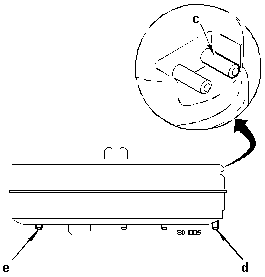
c - Vacuum pump vacuum inlet
d - Outlet:
"Swirl" control butterfly valve
e - Outlet:
variable geometry turbo control diaphragm
Capacity = 0.5
Litre
C - location
The vacuum reserve is located in the engine
compartment, near to the brake servo (depending on vehicle).
Note: The vacuum circuit contains 3 nozzles
of 0.55 mm.
A - Role
The turbocharger is
used to turbocharge the air entering the engine.
The variable
geometry turbocharger is used:
·
to increase the speed of the exhaust gases which strike the
turbine at low engine speeds,
·
to reduce the speed of the exhaust gases which strike the turbine
at high engine speeds,
·
to adapt the turbine to a variation in exhaust gas flow.
B - Description
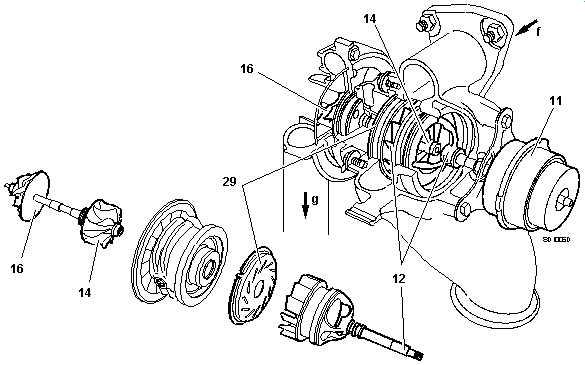
11
- Finned diffuser piston control
diaphragm: vacuum controlled
12
- Finned diffuser piston
14
- Exhaust turbine
16
- Inlet air turbine
29
- Thermal housing
f - Gases
from the exhaust manifold
g - To
inlet manifold
The turbocharger has
two separate chambers.
The turbocharger consists of the following
components:
·
a chamber linked
to the engine exhaust function,
·
a chamber linked
to the inlet function,
·
a turbine and a
compressor, joined together by a shaft.
The turbine, driven by the exhaust gases,
drives the compressor which compresses the inlet air.
The
movement of the piston (12) allows the inlet cross section of the exhaust
turbine to be varied in order to alter the speed of the exhaust gases.
The
regulation electrovalve controls the turbocharging pressure regulator piston
(12).
The turbocharging pressure is regulated
progressively and is controlled by a cartographic map (injection ECU).
Note: Lubrication
of the turbocharger: careful lubrication is required due to the very high
speeds of the moving parts and the high temperatures to be dissipated.
The pressurised oil required for this
function is taken from the engine's oil circuit.
IMPORTANT: Before switching off the engine, it is essential to let the engine
return to idle speed. Failure to comply with this condition will eventually
destroy the turbocharger (due to lack of lubrication).
C - operation at low
engine speed
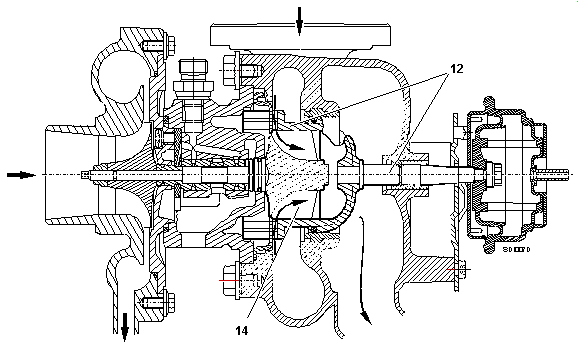
The gas flow passing through the exhaust turbine (14) is low.
To increase the turbocharging pressure, a maximum amount of energy
must be converted in the turbine.
The exhaust gases must be made to pass through a small cross
section: the finned diffuser piston (12) is closed.
Note: The finned diffuser piston is closed when it
is not controlled pneumatically.
D - operation at
high engine speed
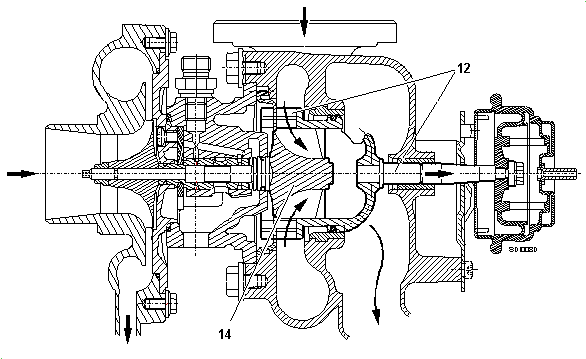
Turbocharging
pressure regulation: the energy of the exhaust gases is controlled by adjusting
the speed at which the gases enter the exhaust turbine by altering the position
of the finned diffuser piston.
Contrary
to a fixed geometry turbocharger, all of the exhaust gas flow passes through
the exhaust turbine (no energy lost).

a - Short inlet duct
(helical shape)
b - Long inlet duct
(tangential)
Using the short inlet duct allows maximum swirl to be obtained
(swirl movement).
Air is let into the inlet ducts by opening the
"Swirl" control butterfly valve at high engine speeds.
Using 2 inlet ducts allows maximum filling (reduced swirl).
Advantages of the variable "Swirl":
·
optimisation of combustion (air/fuel mixture),
·
better performance/pollutant emissions compromise.
The variable "Swirl" gives a reduction in carbon
particles.
A - Role
The Swirl control
electrovalve controls the Swirl control diaphragm.
B - Description
The control
electrovalve connects the vacuum pump and the Swirl control diaphragm.
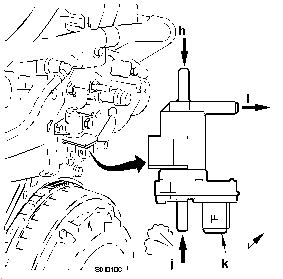
h - Vacuum inlet
from the vacuum reserve
j - Atmospheric pressure inlet
k - Electrical
connector
l - "Usage" outlet
The
electrovalve is controlled with an OCR (Open Cycle Ratio) and using a
cartographic map (injection ECU).
The electrovalve is
subject to the following:
·
atmospheric
pressure,
·
vacuum supplied
by the vacuum pump.
The pressure
supplied by the electrovalve is between atmospheric pressure and the vacuum
from the vacuum pump.
Warning: The "Swirl" control throttle is
closed when it is not controlled pneumatically.
Conditions
allowing the throttle to open:
·
engine speed
above 2100 rpm (at 80°C) (2500 rpm at 0°C),
·
injected fuel
flow greater than 40 mg/stroke.
C - electrical
features
Control: injection ECU (earth).
Full supply (maximum OCR) = maximum vacuum.
No supply (minimum OCR) = no vacuum
(atmospheric pressure).
Resistance at 25 °C = 28 ohms.
D - location
The Swirl control electrovalve is located on
the coolant outlet housing.
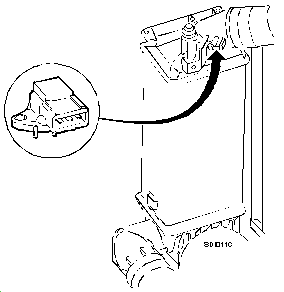
The inlet manifold
pressure sensor is located on the outlet of the air/air heat exchanger.
exhaust gas recycling function
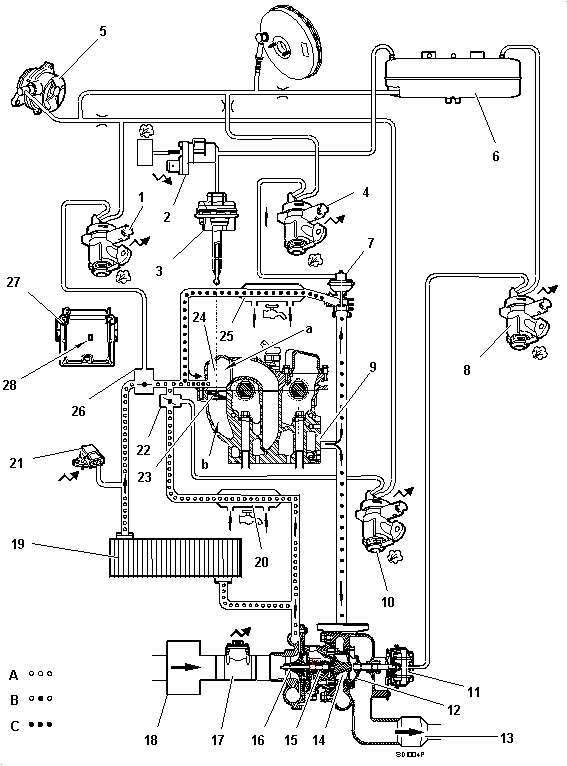
Air circulation (following arrows):
A - Exterior air
inlet
B - Exhaust gases +
air
C - Exhaust gases
a - Short inlet duct (helical shape)
b - Long inlet duct (tangential)
Parts list:
|
REF.
|
DESCRIPTION
|
PART
NUMBER IN THE WIRING DIAGRAMS
|
COMMENTS
|
|
1
|
Throttle housing control electrovalve (EGR)
|
1263
|
|
|
2
|
"Swirl" control electrovalve
|
1264
|
|
|
3
|
"Swirl" control diaphragm
|
--
|
Vacuum controlled
|
|
4
|
Recycling regulation electrovalve (EGR)
|
1253
|
|
|
5
|
Vacuum pump
|
--
|
|
|
6
|
Vacuum reserve
|
--
|
|
|
7
|
Exhaust gas recycling valve (EGR)
|
--
|
Vacuum controlled
|
|
8
|
Turbocharging pressure regulation electrovalve
|
1233
|
|
|
9
|
Exhaust gas manifold
|
--
|
|
|
10
|
Inlet air heater throttle control electrovalve
|
1285
|
|
|
11
|
Variable geometry turbo control diaphragm
|
--
|
Vacuum controlled
|
|
12
|
Finned diffuser piston
|
--
|
|
|
13
|
Particle filter + catalytic converter
|
--
|
|
|
14
|
Exhaust turbine
|
--
|
|
|
15
|
Variable geometry turbocharger
|
--
|
|
|
16
|
Inlet air turbine
|
--
|
|
|
17
|
Air flowmeter + air temperature sensor
|
1310
|
|
|
REF.
|
DESCRIPTION
|
PART
NUMBER IN THE WIRING DIAGRAMS
|
COMMENTS
|
|
18
|
Air filter
|
--
|
|
|
19
|
Air/air heat exchanger
|
--
|
|
|
20
|
Air/water heat exchanger
(inlet air heater)
|
--
|
|
|
21
|
Inlet manifold pressure sensor
|
1312
|
|
|
22
|
Inlet air heater throttle
|
--
|
Vacuum controlled
|
|
23
|
"Swirl" control throttle
|
--
|
|
|
24
|
Inlet air manifold
|
--
|
|
|
25
|
Exhaust gas/coolant exchanger
|
--
|
|
|
26
|
Throttle housing (EGR)
|
--
|
Vacuum controlled
|
|
27
|
Injection ECU
|
1320
|
|
|
28
|
Atmospheric pressure sensor (incorporated into injection ECU)
|
1320
|
|
Note: EGR: exhaust gas recycling.
II - COMPONENTS COMMON WITH DOCUMENT "BOSCH EDC 15C2 HDI INJECTION
SYSTEM"
Components common with the document:
·
air flowmeter
(1310),
·
exhaust gas
recycling valve (EGR),
·
recycling
regulation electrovalve (EGR) (1253).
Specific features of
the DW12 TED4 engine:
·
water/exhaust gas
exchanger (EGR),
·
recycling
regulation electrovalve (EGR) (1253),
·
throttle housing
(EGR),
·
throttle housing
control electrovalve (EGR) (1263).
A - Role
The
water/exhaust gas heat exchanger cools the recycled exhaust gases let into the
cylinders.
B - Location
Location: on the rear of the cylinder head
(bulkhead side).
A - Role
In addition to the
EGR valve, the throttle housing, depending on its position, is used to improve
exhaust gas recycling. The throttle housing is controlled progressively and
using a cartographic map (injection ECU).
Warning: The throttle housing is open when it is not
controlled pneumatically.
B - Location
The throttle
housing is located at the inlet to the inlet manifold.
A - Role
The electrovalve controls the closing of the
throttle housing.
B - Description
The electrovalve is the same as the
following electrovalves:
·
turbocharging
pressure regulation electrovalve,
·
recycling
regulation electrovalve (EGR),
·
inlet air heater
throttle control electrovalve.
The electrovalve connects the vacuum pump to
the throttle housing:
·
the greater the
vacuum, the more the throttle housing closes,
·
the lower the
vacuum, the more the throttle housing opens.
C - Location

The electrovalve is located in the engine
compartment.
hdi system
I - COMPONENTS COMMON WITH DOCUMENT "BOSCH EDC 15C2 HDI INJECTION
SYSTEM"
Components common
with the document:
·
high pressure
fuel pump,
·
high pressure
fuel pump 3rd piston deactivator (1277),
·
high pressure
fuel regulator (1322),
·
high pressure
fuel common injection rail,
·
battery (BB00),
·
double injection
relay (1304),
·
accelerator pedal
sensor (1261),
·
engine speed
sensor (1313),
·
camshaft position
sensor (1115),
·
coolant
temperature sensor (1220),
·
air temperature
sensor (1310),
·
fuel temperature
sensor (1221),
·
high pressure
fuel sensor (1321),
·
vehicle speed
sensor (1620),
·
brake switch
(2100),
·
specific feature
of the diesel injector control.
Specific features of
the DW12 TED4 engine:
·
injection ECU
(1320),
·
diesel injectors
(1331, 1332, 1333, 1334).
III - DOUBLE INJECTION RELAY (BSM) - feature
The double relay is
incorporated into the engine relay unit (BSM).
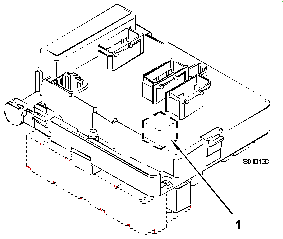
1 - Double relay
A - Role
The coolant temperature sensor informs the
ECU of the temperature of the engine coolant.
Role of the injection ECU depending on the
information received:
·
to adjust the
preheating time,
·
to adjust the
post-heating time,
·
to adjusting the
starting flow,
·
to adjust the
idle speed,
·
to authorise
exhaust gas recycling (EGR),
·
to adjust the
fuel flow,
·
to limit the
injected flow if the coolant temperature is critical (anti-boil function),
·
to control the
operation of the radiator fans,
·
to control the
coolant temperature gauge on the instrument panel (*),
·
to control the
warning and pre-warning LEDs (*).
Note: (*) depending on version.
B - Description
Green 2-way sensor.
The sensor consists of a Negative
Temperature Coefficient resistor (NTC).
The higher the temperature, the lower its
resistance.
C - Location
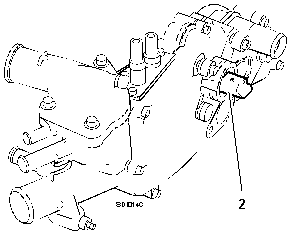
2 - coolant temperature sensor.
The coolant temperature sensor is located on
the coolant housing.
There are 2 types of assembly.
Metal coolant outlet housing.
·
the coolant
temperature sensor is screwed in,
·
it is sealed by a
copper seal.
Plastic coolant outlet housing:
·
the temperature
sensor is secured by a plastic clip,
·
it is sealed by
an O-ring.
A - Role
Role of the injection ECU depending on the
information received:
·
to adjust the
fuel flow,
·
to calculate the fuel
density.
B - Description
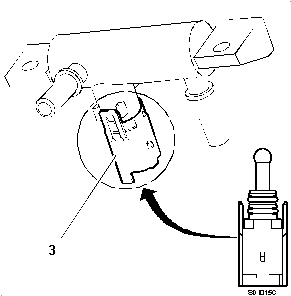
3 - Fuel temperature sensor
The sensor consists of a Negative
Temperature Coefficient resistor (NTC).
The higher the temperature, the lower its
resistance:
·
resistance at 20 °C = 3323 ohms,
·
resistance at 80 °C = 287 ohms.
C - Location
The fuel temperature sensor measures the
temperature of the fuel directly on the tank return circuit.
A - Role
The switch allows the injection ECU to
ensure correct driving comfort.
The electrical information supplied by the
brake switch is transmitted to the BSI and sent to the injection ECU via the
multiplexed network (*).
(*) depending on version.
B - Location
The brake switch is located on the pedal
set.
A - Role
The switch allows the injection ECU to
ensure correct driving comfort.
The information from the brake switches is
constantly compared with each other in order to detect any faults.
B - Location
The brake switch is located on the pedal
set.
A - Role
The clutch switch allows the injection ECU
to perform the driven idle function.
B - Location
The clutch switch is located on the pedal
set.
The vehicle speed
information is transmitted by the ABS ECU on the multiplexed networks.
A - Role
The ECU controls all of the injection
system.
The ECU software incorporates:
·
the functions for
controlling injection and depollution,
·
the driving
pleasure strategies,
·
the engine
immobiliser function,
·
the emergency
strategies,
·
control of the
fan units and warning LEDs (*),
·
control of the
coolant heating systems for the heater matrix (*),
·
diagnostics with
fault memorising,
·
the cruise
control function (*),
·
the dialogue with
all ECUs of the multiplexed networks.
Note: (*) depending on version.
The ECU electrically operates the following
components:
·
diesel injectors,
·
turbocharging
pressure regulation electrovalve,
·
high pressure
fuel regulator,
·
recycling
regulation electrovalve,
·
pre and post
heating unit (post-heating cut-out)
·
high pressure
fuel pump 3rd piston deactivator.
The ECU supplies the following information:
·
engine speed: to
the instrument panel dials
·
instant consumption:
to the trip computer,
·
air conditioning
cut-off,
·
coolant heater
operation authorisation (depending on version).
The atmospheric pressure sensor cannot be
removed from the injection ECU.
The ECU has a power stage which is capable
of providing the very high control current required for the injectors to
operate.
The ECU is connected to the injection
harness by an 88 track connector.
The injection ECU software is upgraded by
downloading (ECU with a flash EPROM).
B - allocation of
ecu channels
|
CHANNEL N°
|
DESCRIPTION
|
|
1
|
+12 V supply (after double relay) (engine relay unit)
|
|
2
|
Injector n°1 control
|
|
3
|
Injector n°3 control
|
|
4
|
Injector n°4 control
|
|
5
|
Injector n°2 control
|
|
6
|
Injector n°2 control
|
|
7
|
-
|
|
8
|
Diagnostic line for the coils of the fan unit control relays
|
|
9
|
Dialogue line: CAN H network
|
|
10
|
-
|
|
11
|
Input: air temperature sensor (flowmeter)
|
|
12
|
Supply: camshaft position sensor / differential pressure sensor
|
|
13
|
Input: air flow signal (flowmeter)
|
|
14
|
Input: engine speed sensor signal
|
|
15
|
Input: accelerator pedal sensor signal
|
|
16
|
-
|
|
17
|
-
|
|
18
|
Input: camshaft sensor signal
|
|
19
|
-
|
|
20
|
-
|
|
CHANNEL N°
|
DESCRIPTION
|
|
21
|
Input: clutch switch
|
|
22
|
Sensors earth
|
|
23
|
---
|
|
24
|
Output: Swirl control
electrovalve
|
|
25
|
Output: fan unit 1 control
(high speed)
|
|
26
|
Output: turbocharging
pressure regulation electrovalve
|
|
27
|
Earth: differential
pressure sensor
|
|
28
|
Output: inlet air heater
throttle control electrovalve
|
|
29
|
+12 volts supply (after
double relay) (engine relay unit)
|
|
30
|
Injector N° 1 control
|
|
31
|
Injector N° 3 control
|
|
32
|
Injector N° 4 control
|
|
33
|
Earth
|
|
34
|
Sensors earth
|
|
35
|
---
|
|
36
|
Engine immobiliser serial
line (*)
|
|
37
|
Dialogue line: CAN L
network
|
|
38
|
K diagnostic line
|
|
39
|
Input: fuel temperature
sensor
|
|
40
|
Earth: camshaft position
sensor
|
|
41
|
Input: engine speed sensor
signal
|
|
42
|
Input: differential
pressure sensor
|
|
43
|
---
|
|
44
|
Sensors supply (5 volts)
|
|
45
|
Earth: coolant temperature
sensor
|
|
46
|
Input: coolant temperature
information
|
|
47
|
---
|
|
48
|
Stop lamps contact
|
|
49
|
Earth
|
|
CHANNEL N°
|
DESCRIPTION
|
|
50
|
---
|
|
51
|
Earth
|
|
52
|
Output: recycling
electrovalve control (EGR)
|
|
53
|
Earth
|
|
54
|
---
|
|
55
|
Output: throttle housing
electrovalve control (EGR)
|
|
56
|
---
|
|
57
|
Output: fan unit control:
mid speed (*)
|
|
58
|
Output: additional heating
control 1
|
|
59
|
---
|
|
60
|
Output: high pressure fuel
regulator
|
|
61
|
---
|
|
62
|
---
|
|
63
|
---
|
|
64
|
---
|
|
65
|
---
|
|
66
|
---
|
|
67
|
Input: preheater unit
diagnostic
|
|
68
|
Input: accelerator pedal
sensor
|
|
69
|
+ ignition on: engine
relay unit (BSM)
|
|
70
|
Input: exhaust gas
temperature sensor (upstream of the catalytic converter)
|
|
71
|
Input: inlet manifold air
pressure
|
|
72
|
---
|
|
73
|
Input: redundant brake
switch
|
|
74
|
Input: fuel pressure
|
|
75
|
Air conditioning
pressurestat (26 bar control stage)
|
|
76
|
---
|
|
77
|
---
|
|
CHANNEL N°
|
DESCRIPTION
|
|
78
|
---
|
|
79
|
---
|
|
80
|
Output: high pressure fuel
pump 3rd piston deactivator
|
|
81
|
---
|
|
82
|
---
|
|
83
|
Output: fan unit control 2
(low speed)
|
|
84
|
---
|
|
85
|
Output: additional heating
control 2
|
|
86
|
Output: double relay
control (engine relay unit)
|
|
87
|
Input: inertia switch
(earthing)
|
|
88
|
Output: preheating unit
control
|
Note: (*) depending on version.
pre-post heating function
I - COMPONENTS COMMON WITH DOCUMENT "BOSCH EDC 15C2 HDI INJECTION
SYSTEM"
Components common
with the document:
·
preheater plugs
(1160),
·
pre-post heating
unit (1150).
The preheater plugs
are located on the cylinder head, on the rear of the engine (bulkhead side).
The preheater plugs
can be activated during particle filter regeneration assistance.
engine cooling function
(fric) (INCORPORATED into
the INJECTION ECU)
The injection ECU performs the following
functions:
·
it switches the fan units on and off (engine cooling),
·
it controls post ventilation (for 6 minutes maximum),
·
it illuminates the coolant temperature warning LED on the instrument panel,
·
it controls the coolant temperature gauge on the instrument panel,
·
it performs diagnostics for fan unit operation,
·
it acquires the engine coolant temperature,
·
it manages downgraded modes.
I - diagram
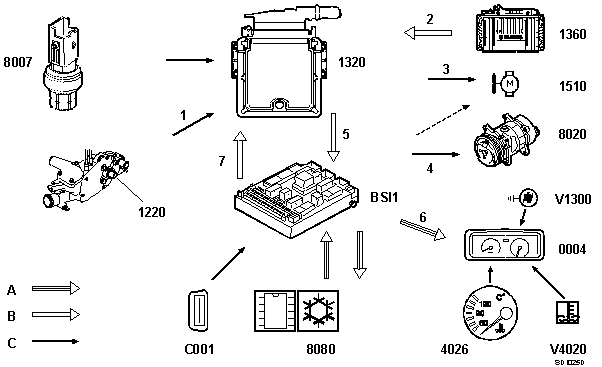
Key:
A - VAN network
B - CAN network
C - Wire connection
|
DESCRIPTION
|
PART
NUMBER IN THE WIRING DIAGRAMS
|
|
Automatic gearbox ECU (*)
|
1360
|
|
Diagnostic LED
|
V1300
|
|
Fan unit
|
1510
|
|
Air conditioning compressor
|
8020
|
|
Control panel (logometer + warning LED on the control panel
|
0004
|
|
Coolant temperature warning LED
|
V4020
|
|
Coolant temperature logometer
|
4026
|
|
Built-in systems interface
|
BSI1
|
|
Central diagnostic socket
|
C001
|
|
Injection ECU
|
1320
|
|
Air conditioning ECU
|
8080
|
|
Air conditioning pressurestat
|
8007
|
|
Coolant temperature sensor
|
1220
|
Note: (*)
depending on version.
|
CONNECTIONS
|
|
CONNECTION
N°
|
SIGNAL
|
SIGNAL
NATURE
|
|
1
|
Coolant temperature sensor
|
Frequency
|
|
2
|
Request for automatic gearbox oil temperature cooling (*)
|
CAN
|
|
3
|
Fan unit relay control: low speed (1508)
|
All or nothing
|
|
|
Fan unit relay control: high speed (1509)
|
All or nothing
|
|
4
|
Air conditioning compressor control
|
All or nothing
|
|
5
|
Request to illuminate diagnostic LED
|
CAN
|
|
|
Request to illuminate coolant temperature logometer
|
CAN
|
|
|
Request to illuminate coolant temperature warning LED
|
CAN
|
|
|
Authorisation to engage the air conditioning compressor (AC/OUT)
|
CAN
|
|
6
|
Request to illuminate diagnostic LED
|
VAN
|
|
|
Request to illuminate coolant temperature logometer
|
VAN
|
|
|
Request to flash coolant temperature warning LED
|
VAN
|
|
7
|
Request to authorise engaging of the air conditioning compressor
(AC/TH)
|
CAN
|
Note: (*) depending on vehicle equipment.
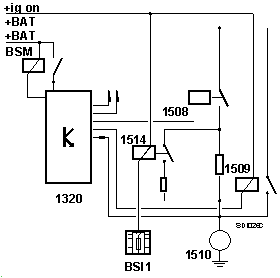
+BAT = + battery
+ig on = + ignition
on
BSM - Double
injection relay
1514 - Fan unit
relay at mid speed
There is only one
type of assembly: three speed fan unit.
Warning: The limits for engaging the fan unit depend
on the vehicle: refer to the corresponding documentation.
There are three
operating speeds:
·
low speed = 97°C,
·
mid speed,
·
high speed = 105°C.
A - Description
Low speed is obtained by supplying the fan
unit through a resistor arranged in series on the supply circuit.
Mid speed is obtained by supplying the fan
unit through 2 resistors arranged in parallel in the supply circuit:
- the low speed relay is controlled by the
injection ECU,
- the mid speed relay is controlled by the
built-in systems interface,
- high speed is obtained by supplying the
fan unit directly.
Before switching to high speed, the fan unit
is operated at low speed for 3 seconds.
Before switching to mid speed, the fan unit
is operated at low speed for 3 seconds (*).
(*) refer to the procedure: cooling
requirements for the air conditioning (BRAC).
B - electrical
resistors
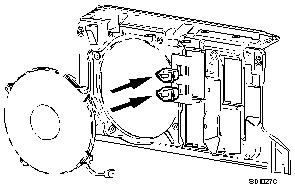
The 2 resistors are located on the front
panel, near to the air/air exchanger and the fan unit.
The coolant
temperature sensor informs the ECU of the temperature of the engine coolant.
The coolant
temperature sensor is located on the coolant housing.
IV - POST
VENTILATION
When the engine is
switched off, the ECU controls post ventilation if the coolant temperature
exceeds a certain limit (*) (105°C).
(*) depending on
vehicle
Post ventilation
occurs at low speed and lasts for a maximum of 6 minutes after the engine is
switched off.
Role of the
injection ECU when the coolant temperature sensor is faulty:
·
to control
operation of the fan unit at high speed,
·
to control the
flashing of the coolant temperature warning LED on the control panel (depending
on version),
·
to prevent the
air conditioning compressor from being engaged (AC/OUT).
cooling requirements for
the air conditioning (brac) (incorporated
into the INJECTION ECU)
Functions of the injection ECU:
·
to operate the fan units (air conditioning condenser cooling),
·
to acquire the pressure of the air conditioning circuit,
·
to manage downgraded modes.
I - diagram
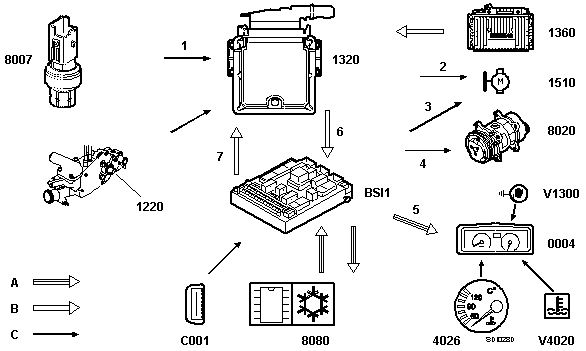
Key:
A - VAN network
B - CAN network
C - Wire connection
|
DESCRIPTION
|
PART
NUMBER IN THE WIRING DIAGRAMS
|
|
Automatic gearbox ECU (*)
|
1360
|
|
Diagnostic LED
|
V1300
|
|
Fan unit
|
1510
|
|
Air conditioning compressor
|
8020
|
|
Instrument panel
|
0004
|
|
Coolant temperature warning LED
|
V4020
|
|
Coolant temperature gauge
|
4026
|
|
Built-in systems interface
|
BSI1
|
|
Central diagnostic socket
|
C001
|
|
Injection ECU
|
1320
|
|
Air conditioning ECU
|
8080
|
|
Air conditioning pressurestat
|
8007
|
|
Coolant temperature sensor
|
1220
|
Note: (*)
depending on version.
|
CONNECTIONS
|
|
CONNECTION
N°
|
SIGNAL
|
SIGNAL
NATURE
|
|
1
|
Air conditioning
pressurestat
|
Analogue
|
|
2
|
Fan unit relay control:
low speed (1508)
|
All or nothing
|
|
|
Fan unit relay control:
high speed (1509)
|
All or nothing
|
|
3
|
Fan unit relay control: mid
speed (1514)
|
All or nothing
|
|
4
|
Air conditioning
compressor control
|
All or nothing
|
|
5
|
Request to illuminate
diagnostic LED
|
VAN
|
|
6
|
Request to illuminate
diagnostic LED
|
CAN
|
|
|
Authorisation to engage
air conditioning compressor (AC/OUT)
|
CAN
|
|
|
Air conditioning
pressurestat
|
CAN
|
|
7
|
Request authorisation to
engage air conditioning compressor (AC/TH)
|
CAN
|
A - Role
The sensor measures the value of the
pressure in the air conditioning circuit.
Role of the injection ECU depending on the
information received:
·
to authorise
operation of the fan unit (air conditioning condenser cooling),
·
to authorise
engaging of the air conditioning compressor.
B - Description

The sensor is of piezo-electric type.
The sensor consists of strain gauges.
The linear sensor supplies a voltage
proportional to the pressure in the air conditioning circuit.
Identification: black connector.
Note: The electrical information provided by
the sensor is transmitted by wire to the injection ECU, and sent to the
built-in systems interface via the multiplexed network.
C - electrical
features
Allocation of connector channels:
·
channel 1: 5
volts supply,
·
channel 2:
pressure information (0 - 5 volts),
·
channel 3: earth.
Voltage supplied for a pressure of 1 bar: +
0.5 volt.
Voltage supplied for a pressure of 31 bars:
+ 4.5 volts.
D - Location
The sensor is located on the air
conditioning condenser.
The ECU controls
operation of the fan unit at low speed if the pressure is greater than 10 bars
(off if the pressure is less than 7 bars).
The ECU controls
operation of the fan unit at high speed if the pressure is greater than 22 bars
(off if the pressure is less than 19 bars).
Note: The BSI controls operation of the fan unit
at mid speed if the pressure is greater than 17 bars (off if the pressure is
less than 14 bars).
Role of the
injection ECU if the pressurestat develops a fault:
·
to control the
illumination of the diagnostic LED on the control panel,
·
to prevent
operation of the air conditioning compressor (AC/OUT).
particle filter function
I - diagram
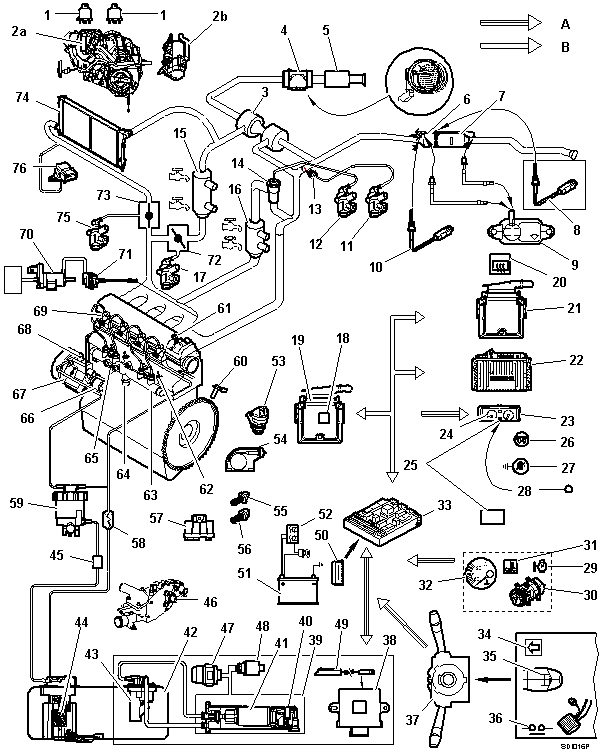
Key:
A - VAN network
B - CAN network
|
REF.
|
DESCRIPTION
|
PART NUMBER IN THE WIRING DIAGRAMS
|
|
1
|
Additional heating control relay
|
BCP3
|
|
2
|
Additional heating (electrical
resistors (2a) or heater (2b)) (*)
|
8098
- 1190
|
|
3
|
Variable geometry turbocharger
|
--
|
|
4
|
Air flowmeter / air temperature
sensor
|
1310
|
|
5
|
Air filter
|
--
|
|
6
|
Catalytic converter
|
--
|
|
7
|
Particle filter
|
--
|
|
8
|
Exhaust gas temperature sensor
(downstream of the catalytic converter)
|
1343
|
|
9
|
Differential pressure sensor
|
1341
|
|
10
|
Exhaust gas temperature sensor
(upstream of the catalytic converter)
|
1344
|
|
11
|
Turbocharging pressure regulation
electrovalve
|
1233
|
|
12
|
Recycling regulation electrovalve
(EGR)
|
1253
|
|
13
|
Variable geometry turbo control
diaphragm
|
--
|
|
14
|
Exhaust gas recycling valve (EGR)
|
--
|
|
15
|
Air/water heat exchanger (inlet air
heater)
|
--
|
|
16
|
Coolant/exhaust gas exchanger (EGR)
|
--
|
|
17
|
Inlet air heater throttle control
electrovalve
|
1285
|
|
18
|
Atmospheric pressure sensor
(incorporated into the injection ECU)
|
1320
|
|
19
|
Injection ECU
|
1320
|
|
20
|
Heated rear screen
|
8120
|
|
21
|
Electronic stability program ECU (*)
|
7800
|
|
22
|
Automatic gearbox ECU (*)
|
1360
|
|
23
|
Trip computer (*)
|
--
|
|
24
|
Electronic rev counter
|
4210
|
|
25
|
Service LED (*)
|
--
|
|
26
|
Preheater LED
|
V1150
|
|
27
|
Diagnostic LED
|
V1300
|
|
28
|
Fuel gauge (*)
|
--
|
|
29
|
Fan unit
|
1510
|
|
REF.
|
DESCRIPTION
|
PART NUMBER IN THE WIRING DIAGRAMS
|
|
30
|
Air conditioning compressor
|
8020
|
|
31
|
Coolant temperature warning LED
|
V4020
|
|
32
|
Coolant temperature gauge
|
4026
|
|
33
|
Built-in systems interface
|
BSI1
|
|
34
|
Cruise control switch
|
7300
|
|
35
|
Cruise control safety contact
|
7305
|
|
36
|
Redundant brake switch
|
7308
|
|
37
|
Switch module at the steering wheel
(COM2000)
|
CV00
|
|
38
|
Fuel additive ECU
|
1282
|
|
39
|
Additive tank
|
---
|
|
40
|
Low additive level sensor
|
1283
|
|
41
|
Additive injection pump
|
1283
|
|
42
|
Fuel tank
|
--
|
|
43
|
Additive injector
|
1284
|
|
44
|
Low pressure pump
|
1211
|
|
45
|
Electric fuel heater
|
1276
|
|
46
|
Coolant temperature sensor
|
1220
|
|
47
|
Plug (overflow)
|
--
|
|
48
|
Safety valve
|
---
|
|
49
|
Fuel filler cap presence sensor (*)
|
4320
|
|
50
|
Central diagnostic socket
|
C001
|
|
51
|
Battery
|
BB00
|
|
52
|
Double injection relay (engine relay
unit)
|
BSM
|
|
53
|
Vehicle speed sensor
|
1620
|
|
54
|
Accelerator pedal position sensor
|
1261
|
|
55
|
Clutch pedal switch
|
7306
|
|
56
|
Brake pedal switch
|
2100
|
|
57
|
Pre-post heating unit
|
1150
|
|
58
|
Fuel cooler
|
--
|
|
59
|
Fuel filter
|
--
|
|
60
|
Engine speed sensor
|
1313
|
|
61
|
Camshaft position sensor
|
1115
|
|
62
|
Preheater plugs
|
1160
|
|
REF.
|
DESCRIPTION
|
PART NUMBER IN THE WIRING DIAGRAMS
|
|
63
|
High pressure
fuel common injection rail
|
--
|
|
64
|
High pressure
fuel sensor
|
1321
|
|
65
|
Fuel
temperature sensor
|
1310
|
|
66
|
High pressure
fuel regulator
|
1322
|
|
67
|
High pressure
fuel pump
|
--
|
|
68
|
High pressure
fuel pump 3rd piston deactivator
|
1277
|
|
69
|
Diesel
injectors
|
1331 - 1332 - 1333 - 1334
|
|
70
|
Swirl control
electrovalve
|
1264
|
|
71
|
Swirl control
diaphragm
|
--
|
|
72
|
Inlet air
heater throttle
|
--
|
|
73
|
Throttle
housing (EGR)
|
--
|
|
74
|
Air/air heat
exchanger
|
--
|
|
75
|
Throttle
housing control electrovalve (EGR)
|
1263
|
|
76
|
Inlet manifold
pressure sensor
|
1312
|
Note: (*) depending on version.
A - Role
The particle filter traps carbon particles
as exhaust gases pass through.
B - Description
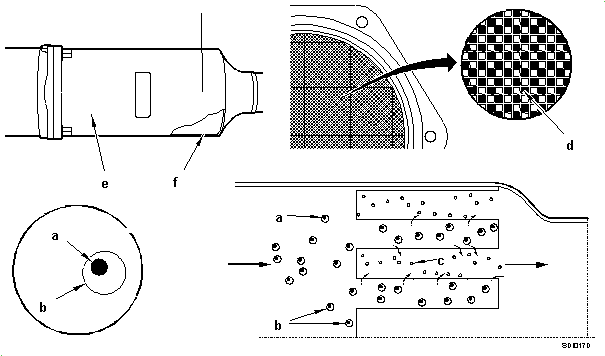
a - Carbon particles
b - Cerine
c - Filtered
exhaust gases
d - Porous ceramic
walls
e - Stainless steel
casing
f - Thermal insulator
The particle filter is a porous silicon
carbide structure containing channels arranged so as to force the exhaust gases
to pass through the walls.
Components retained in the particle filter:
·
carbon particles,
·
cerine,
·
deposits from the
engine oil and engine wear.
Essentially consisting of carbon and
hydrocarbons, these particles attached to the particle filter burn in the
presence of oxygen at a temperature of 550°C (natural regeneration or assisted
with post-injection).
Cerine is an inorganic material which does
not burn and is retained in the particle filter in the form of a solid deposit.
The accumulation of particles during engine
operation leads to the progressive clogging up of the particle filter.
Warning: The particle filter must be replaced or
cleaned every 80 000 km (in order to remove the particles retained in the
filter). Refer to the maintenance section.
C - Location
The particle filter is incorporated into the
exhaust pipe (downstream of the catalytic converter).
A - Role
The catalytic converter is used to increase
the temperature of the exhaust gases, through post-combustion of the unburned
hydrocarbons (HC) resulting from post-injection.
B - Description
Composition of an oxidation catalytic
converter:
·
a stainless steel
envelope,
·
a thermal
insulator,
·
a ceramic
honeycombed monolith impregnated with precious metals.
C - Location
The catalytic converter is located
immediately after the particle filter.
A - Role
The temperature sensor informs the injection
ECU of the temperature of the exhaust gases (upstream of the catalytic
converter).
B - Description

The sensor consists of a Negative
Temperature Coefficient resistor (NTC).
The higher the
temperature, the lower its resistance.
C - electrical
features
Allocation of
connector channels:
·
channel 1: 5
volts,
·
channel 2: earth.
Resistance at 100°C = 96 000 ohms.
Resistance at 450°C = 762 ohms.
Warning: The electrical information provided by the
upstream temperature sensor is transmitted directly to the injection ECU.
D
- Location
The temperature
sensor is located upstream of the catalytic converter.
The temperature
sensor is screwed onto a base.
IMPORTANT: Use the correct tightening torque.
A - Role
The temperature sensor informs the injection
ECU of the temperature of the exhaust gases (downstream of the catalytic
converter).
B - Description
The downstream temperature sensor is
identical to the upstream temperature sensor.
C - electrical
features
Warning: The electrical information provided by the
downstream temperature sensor is transmitted by wire to the additive ECU and
sent to the injection ECU via the multiplexed networks.
D - Location
The temperature sensor is located between
the catalytic converter and the particle filter.
A - Role
The sensor
permanently measures the pressure difference of the exhaust gases, between the
inlet and the outlet of the particle filter, to determine the status of the
filter (clogging problems or damage to filter).
B - Description

g - HI: Particle
filter upstream information input (diameter 4.32 mm)
h - REF: Particle
filter downstream information input (diameter 4.32 mm)
j - White marking
k - Electrical
connector
l - Membrane
The sensor
comprises the following components:
·
electronics for
amplifying the signal,
·
a sealed
membrane.
The membrane is
subject to the following pressures:
·
the inlet
pressure of the particle filter (upstream),
·
the outlet
pressure of the particle filter (downstream).
The sensor provides
a voltage proportional to the pressure differential measured by the membrane
(pressure differential = upstream pressure - downstream pressure).
IMPORTANT: Do not invert the
upstream and downstream information pipes (malfunction of the filtration
system). Management of the particle filter depends on this information.
C - electrical
features
Allocation of connector channels:
·
channel 1:
pressure information (0.5 - 5 volts),
·
channel 2: earth,
·
channel 3: 5
volts supply
Voltage supplied for a pressure differential
of 0 bar: + 0.5 volt (engine off).
Voltage supplied for a pressure differential
of 0.9 bar: + 4.1 volts (particle filter clogged).
D - Location
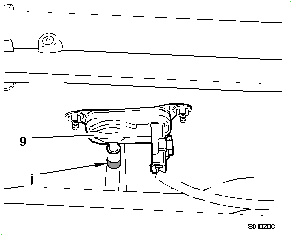
j - white marking
The sensor (9) is located in the centre of
the bulkhead at the top (depending on vehicle).
The air temperature
sensor informs the ECU of the temperature of the inlet air.
Warning: The air temperature sensor is incorporated
into the air flowmeter.
Role of the
injection ECU depending on the information received:
·
to regulate the temperature of the inlet air by operating the inlet air
heater throttle control electrovalve.
Note: When the air temperature sensor (1310) is
faulty, the ECU uses a replacement value of 50°C.
Note: The information from the exterior air
temperature sensor (6415) located in the door mirror is used by the ECU to
perform comparison tests. The exterior air sensor is controlled by the front RH
door station (9050).
A - Role
The air/water heat exchanger heats the inlet
air in the cylinders (during the particle filter regeneration assistance
phase).
The inlet air
heater is used to increase the combustion temperature required to regenerate
the particle filter.
B - Description
The air/air heat exchanger, which cools the
inlet air in the cylinders, is surrounded by an air/water exchanger which heats
the inlet air.
C - Location
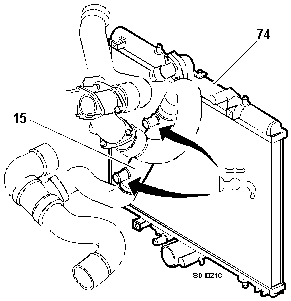
15 - air/water heat
exchanger (inlet air heater)
74 - air/air heat exchanger
The water/air heat
exchanger (15) is located near to the front air/air heat exchanger (74).
A - Description
Warning: The inlet air heater throttle is closed when it is not
controlled pneumatically.
B - Location
The throttle
housing is located at the inlet to the inlet manifold.
A - Role
The electrovalve controls the opening of the
inlet air heater throttle.
B - Description
The electrovalve is the same as the
following electrovalves:
·
turbocharging
pressure regulation electrovalve,
·
exhaust gas
recycling electrovalve (EGR),
·
throttle housing
control electrovalve (EGR).
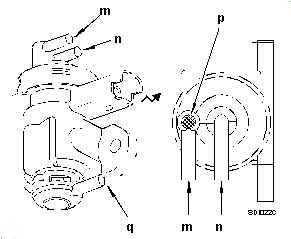
m -
"user" output
n - vacuum pump vacuum inlet
p - white marking
q - atmospheric pressure inlet
The electrovalve is controlled with an OCR
(open cycle ratio).
The proportional electrovalve controlled
with an OCR voltage is connected to the following:
·
atmospheric
pressure,
·
vacuum supplied
by the vacuum pump.
The pressure supplied by the electrovalve is
between atmospheric pressure and the vacuum from the vacuum pump.
The electrovalve connects the vacuum pump
and the heater throttle.
Operating phases with particle filter
regeneration assistance:
·
engine at low
load and mid load: the inlet air heater throttle is open (controlled),
·
engine at full
load: the inlet air heater throttle is closed (not controlled) (in moderate
ambient temperature).
Note: The
inlet air heater throttle can be controlled outside the regeneration assistance
operating phase (engine cold, moderate ambient temperature).
C - electrical
features
Control: injection ECU (earth).
Variable voltage control (OCR):
·
full supply
(maximum OCR) = maximum vacuum,
·
no supply
(minimum OCR) = no vacuum (atmospheric pressure).
D - Location

17 - inlet air heater throttle control
electrovalve
The electrovalve is
located between the air filter housing and the inlet manifold. It has a 2 way
orange connector.
A - Role
The electrovalve controls the closing of the
throttle housing (EGR).
B - Description
Warning: The throttle housing is open when it is not
controlled pneumatically.
Operating phases with particle filter
regeneration assistance:
·
engine at low
load: the throttle housing is closed (controlled) (**) (depending on exterior
temperature),
·
engine at mid
load and full load: the throttle housing is open (not controlled).
(**) the engine only lets in heated air.
The electrovalve has a 2 way black
connector.
A - Role
The BSI performs the following operations:
·
it transmits
information from the fuel additive ECU to the injection ECU,
·
it transmits
information from the injection ECU to the fuel additive ECU,
·
it informs the
driver of the status of the pollutant particle filtration system,
·
it reinitialises
the system after a maintenance operation.
B - diagram

Key:
A - VAN network
B - CAN network
C - Wire connection
BSI1 - Built-in
systems interface
1282 - Fuel
additive ECU
1320 - Injection
ECU
|
CONNECTIONS
|
|
CONNECTION
N°
|
SIGNAL
|
SIGNAL NATURE
|
|
77
|
Operating status of the additive ECU
|
CAN
|
|
|
Low additive level reached warning
|
CAN
|
|
|
Total quantity of additive injected
since start of particle filter's life
|
CAN
|
|
|
Exhaust gas temperature (downstream
of the catalytic converter)
|
CAN
|
|
|
Request to force fan unit (at low
speed)
|
CAN
|
|
|
Request to force pre-post heater
plugs
|
CAN
|
|
78
|
Request to illuminate diagnostic LED
|
VAN
|
|
|
Particle filter fault
|
CAN
|
|
|
Request to activate consumers
(alternator saturation)
|
CAN
|
|
|
Request to force fan unit (at mid
speed)
|
CAN
|
|
|
Engine speed sensor signal (engine
running information)
|
CAN
|
|
79
|
Pre-post heating unit / preheater
plugs control
|
All
or nothing
|
|
80
|
Fan unit relay control (at low speed)
|
All
or nothing
|
|
81
|
Fan unit relay control (at mid speed)
|
All
or nothing
|
|
82
|
Heated rear screen relay control
|
All
or nothing
|
|
83
|
Request to illuminate diagnostic LED
|
VAN
|
|
|
Request to flash service LED on the
control panel (*)
|
VAN
|
|
|
Request to display a message on the
multifunction screen (*)
|
VAN
|
|
84
|
Operating status of the additive ECU
|
VAN
|
|
|
Low additive level reached warning
|
VAN
|
|
|
Total quantity of additive injected
since start of particle filter's life
|
VAN
|
|
|
Status of the fuel filler cap
presence sensor
|
VAN
|
|
|
Exhaust gas temperature (downstream
of the catalytic converter)
|
VAN
|
|
CONNECTIONS
|
|
CONNECTION
N°
|
SIGNAL
|
SIGNAL NATURE
|
|
85
|
Engine speed
sensor signal (engine running information)
|
VAN
|
|
|
Fuel sender
information
|
VAN
|
|
|
Ignition key
position
|
VAN
|
|
|
Vehicle speed
information
|
VAN
|
|
86
|
Fuel filler cap
presence sensor
|
All or nothing
|
|
87
|
Exhaust gas
temperature (downstream of the catalytic converter)
|
Analogue
|
|
88
|
Fuel sender
|
Analogue
|
|
89
|
Ignition key
|
All or nothing
|
(*) depending on equipment.
A - Role
The ECU software performs:
·
the functions for
controlling injection and depollution,
·
the control of
particle filter regeneration,
·
the driving
pleasure strategies,
·
the emergency
strategies,
·
the control of
the fan units and warning LEDs (*),
·
the diagnostic
function with memorising of faults,
·
the dialogue with
the fuel additive ECU,
·
the dialogue with
the automatic gearbox ECU (*),
·
the dialogue with
the electronic stability program ECU (*).
(*) depending on equipment.
B - Description
The ECU is responsible for electrically
controlling the following components:
·
differential
pressure sensor,
·
exhaust gas
temperature sensor (upstream of the catalytic converter),
·
inlet air heater
throttle control electrovalve.
fuel additive function
A - Role
Role of the additive:
·
to lower the
particle combustion temperature to 450°C (instead of 550°C),
·
to impregnate the
particles forming in the combustion chamber,
·
to propagate
combustion of the particles.
B - Description
EOLYS additive (supplied by RHODIA).
Composition:
·
cerine: 4.2% by
weight (DP X42),
·
catalytic
converter: brown in colour,
·
solvent product
(combustible hydrocarbon).
A - Description
Specifications:
·
capacity: 5
litres,
·
range: 80 000 km,
·
integrated
additive injection pump,
·
integrated low
additive level sensor,
·
4 orifices.
Orifices:
·
additive injection
pump outlet (10 mm diameter click-fit connector),
·
additive
injection pump return (8 mm diameter click-fit connector),
·
breather
(pressure - vacuum safety valve),
·
degassing
(overflow).
Filling: refer to the procedure given in the
mechanical file of the vehicle in question.
B - Location
Location: under the fuel tank.
A - Role
The additive
injection pump supplies the pressure and the flow required in the additive
circuit.
B - Description
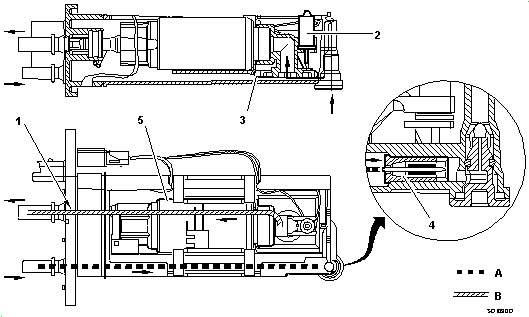
A - Additive return
circuit
B - Additive low
pressure circuit
Supplier: MARWAL
The additive
injection pump comprises the following components:
1 - Non return
valve (additive low pressure circuit)
2 - Low additive
level sensor
3 - Filter
4 - Non return valve
(additive tank return circuit)
5 - Roller
displacement pump
The non return
valves prevent additive from flowing out when the additive injection pump
outlet and return click-fit connectors are opened.
Note: Safety valve rating: 0.2 bar.
Pump flow: 80 l/h.
Normal operating
pressure: 3 bars.
The additive pump
is supplied with 12 volts by the fuel additive ECU in the following cases:
- for 5 seconds
when the ignition is switched on
- during the
additive phase
C - electrical
features
Controlled by the
fuel additive ECU.
Allocation of
connector channels:
·
channel 1: (-)
low additive level sensor,
·
channel 2: (+)
low additive level sensor,
·
channel 3:
additive injection pump 12 volt supply,
·
channel 4:
additive injection pump earth,
·
channel 5: spare,
·
channel 6: spare.
D - Location
The pump is submerged in the additive tank.
Note: The pump cannot be separated from the
additive tank.
A - Role
The sensor informs
the additive ECU that the low additive level has been reached when there is 0.3
litres remaining in the additive tank.
Depending on the
information received, the additive ECU informs the fuel injection ECU.
The injection ECU
informs the BSI which requests activation of the following:
·
request to flash
the service LED on the control panel (*),
·
request to
display a message on the multifunction screen (*).
Note: 0.3 litres of additive is sufficient to
fill up the tank 6 times with 80 litres of fuel (*).
(*) depending on
vehicle equipment.
B - Description
The sensor consists
of a thermistor.
The information
provided varies, depending on whether the thermistor is in the additive or in
air (minimum level reached).
C - Location
The sensor is incorporated into the additive
injection pump.
A - Role
Role of the safety valve:
·
sealing function
(prevents the solvent from evaporating and the ingress of dust, mud and water),
·
overturn safety
function,
·
breather for the
additive tank depending on the additive level.
B - Description
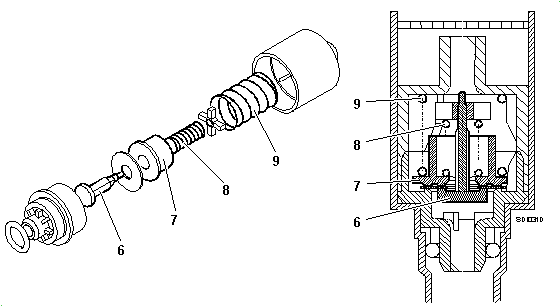
6 - Vacuum valve (0.036 bar)
7 - Pressure relief
valve (0.05 +/- 0.01 bar)
8 - Vacuum valve
return spring
9 - Pressure relief
valve return spring
Operation:
·
the valve (6)
acts as a breather for the additive tank depending on the additive level,
·
the valve (8)
performs the sealing and overturn safety function.
C - Location
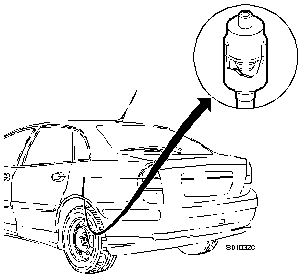
The safety valve is located in the rear left
hand wheel arch (behind the mud flap).
A - Role
The injector is
used to inject a set amount of additive into the fuel tank.
B - Description

Type: WEBER IWP 043
Note: Safety
valve rating: 3 bars.
C - electrical
features
Controlled by the
fuel additive ECU.
Allocation of connector channels:
·
channel 1: +12
volts supply,
·
channel 2: control.
Electrical specifications: resistance at 25 °C = 14.7 ohms.
C - Location
The additive
injector is located on the fuel tank.
A - Role
The fuel filler cap presence sensor informs
the additive ECU whether the fuel filler cap is open or closed.
Role of the additive ECU depending on the
information received: to detect whether fuel may have been added.
B - Description
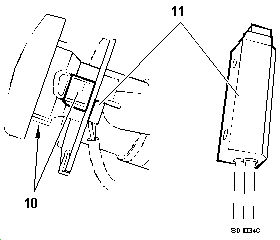
10 - Permanent magnet
11 - Contact
The filler cap is fitted with a magnet. When
the cap is closed, the magnet is opposite the contact.
C - Electrical
features
Supply: fuel additive ECU.
Allocation of connector channels:
·
channel 1: 5 volt
supply,
·
channel 2:
signal,
·
presence of the
magnet opposite the contact: resistance = 150 000 ohms,
·
absence of the
magnet opposite the contact: resistance = 15 ohms.
A - Role
The fuel sender informs the additive ECU of
a variation in fuel level, through the built-in systems interface.
Role of the additive ECU depending on the
information received:
·
to determine the amount
of additive to be injected,
·
to control the
additive injection pump,
·
to control the
additive injector.
B - Description
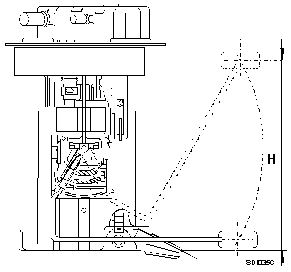
Controlled by the
fuel sender.
Supplier VDO:
|
HEIGHT OF THE FLOAT AXIS IN RELATION TO THE BASE
LEVEL
|
RESISTANCE
|
|
14 mm
|
350 ± 5 ohms
|
|
44 mm
|
300 ± 5 ohms
|
|
75 mm
|
250 ± 5 ohms
|
|
110 mm
|
200 ± 5 ohms
|
|
139 mm
|
150 ± 5 ohms
|
|
171 mm
|
100 ± 5 ohms
|
|
202 mm
|
50 ± 5 ohms
|
Supplier MARWAL:
|
HEIGHT OF THE FLOAT AXIS IN RELATION TO THE BASE
LEVEL
|
RESISTANCE
|
|
14 mm
|
350 ± 11 ohms
|
|
41 mm
|
300 ± 10 ohms
|
|
72 mm
|
250 ± 10 ohms
|
|
104 mm
|
200 ± 9 ohms
|
|
138 mm
|
150 ± 9 ohms
|
|
171 mm
|
100 ± 8 ohms
|
|
204 mm
|
50 ± 2 ohms
|
Note: The fuel sender cannot detect a
variation in fuel level of less than 7 litres precisely.
The BSI sends the additive ECU the following
information:
·
engine speed
sensor signal (engine running information),
·
vehicle speed
information,
·
fuel sender
information,
·
ignition key
position.
A - Role
The ECU controls additive injection.
The ECU software is responsible for:
·
controlling the
start of additive injection and additive injection time into the fuel tank,
·
managing the
total amount of additive injected since the beginning of the filter's life,
·
the emergency
strategies,
·
diagnostic with
memorising of faults,
·
dialogue with the
injection ECU.
B - Description
The ECU electrically controls the following
components:
·
low additive
level sensor,
·
additive
injection pump,
·
additive
injector,
·
fuel filler cap
presence contact,
·
catalytic
converter downstream exhaust gas temperature sensor.
Supplier: MAGNETTI MARELLI.
C - Electrical
features
Allocation of
connector channels:
|
CHANNEL N°
|
DESCRIPTION
|
|
1
|
+ 12 volt supply
(permanent +BAT)
|
|
2
|
+BAT BSI / + ignition on
supply
|
|
3
|
+BODY VAN supply (+12
volts)
|
|
4
|
Input: fuel filler cap
presence sensor information
|
|
5
|
Input: low additive level
sensor information
|
|
6
|
-
|
|
7
|
-
|
|
8
|
Output: additive injector
12V control
|
|
9
|
Output: additive injection
pump 12V control
|
|
10
|
Input: catalytic converter
downstream exhaust gas temperature sensor information
|
|
11
|
Input: catalytic converter
downstream exhaust gas temperature sensor information
|
|
12
|
Input: fuel filler cap
presence sensor information
|
|
13
|
Input: low additive level
sensor information
|
|
14
|
VAN Data network
|
|
15
|
VAN Data bar network
|
|
16
|
Earth
|
D - Location
Location: on the chassis member near to the
bottom of the RH centre post (depending on vehicle).
operating phases:
hdi direct injection system
I - COMPONENTS COMMON WITH DOCUMENT "BOSCH EDC 15C2 HDI INJECTION
SYSTEM"
Components common
with the document:
·
foreword,
·
injection
diagram,
·
role of the main
cartographic maps,
·
general
operation,
·
working out the
amount of fuel to inject,
·
high pressure
fuel regulation,
·
direct injection,
·
working out the
injection type,
·
turbocharging
pressure regulation,
·
starting the
engine,
·
stopping the
engine,
·
engine operating
safety,
·
driver's
information function.
Specific features of
the DW12TED4 engine:
·
turbocharging
pressure regulation,
·
exhaust gas recycling
regulation,
·
pre-post heating,
·
additional
heating,
·
air conditioning
compressor cut-off,
·
displaying
faults,
·
downgraded
operating modes.
The turbocharging
pressure is reduced to prevent the turbocharger from being damaged in the
following cases:
·
when the altitude
is above 500 m,
·
when the exterior
air temperature is above 28°C (at the inlet manifold inlet).
During part of the
EGR phase (low engine speed / low load), the turbocharging pressure is
controlled in an open loop to prevent any interference on the air loop.
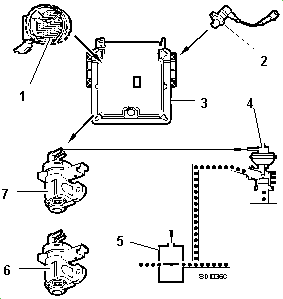
1 - Air flowmeter
2 - Engine speed
sensor
3 - Injection ECU
4 - Exhaust gas
recycling valve (EGR)
5 - Throttle housing
(EGR)
6 - Throttle housing
control electrovalve (EGR)
7 - Recycling
regulation electrovalve (EGR)
Exhaust gas
recycling is of progressive type and is controlled by a cartographic map.
Role of the
injection ECU depending on the information received (exhaust gas recycling rate
determined in the cartographic map):
·
to control the
exhaust gas recycling electrovalve with an OCR voltage,
·
to determine the
exhaust gas recycling rate,
·
to correct the
OCR applied to the exhaust gas recycling electrovalve so as to obtain the theoretical
recycling rate equal to the measured rate.
Note: Exhaust gas recycling rate = difference
between the measurement from the air flowmeter and the calculation of the
amount of air entering the engine (depending on engine speed and air
temperature).
Conditions allowing
exhaust gas recycling:
·
engine speed
greater than 725 rpm,
·
low engine load,
·
coolant
temperature (ECU cartographic map) / air temperature (ECU cartographic map),
·
regeneration
assistance not active.
Conditions prohibiting exhaust gas recycling:
·
full engine load,
·
engine speed
greater than 2650 rpm,
·
altitude above
1500 m,
·
coolant
temperature above 105°C,
·
regeneration
assistance active.
Throttle housing (EGR):
·
in addition to
the recycling valve, the throttle housing, depending on its position, is used
to improve exhaust gas recycling,
·
the throttle
housing is controlled progressively and using a cartographic map (injection
ECU).
The preheating and
postheating times are determined by the ECU depending on the coolant
temperature.
The preheating time varies as a function of coolant
temperature.
|
COOLANT TEMPERATURE
|
PREHEATING TIME
|
|
- 25°C
|
15 seconds
|
|
- 18°C
|
10 seconds
|
|
- 10°C
|
0.5 seconds
|
|
- 1°C
|
0.5 seconds
|
During the cranking
phase, the plugs are energised in the following cases:
·
coolant
temperature below 25°C?
·
engine speed less
than 70 rpm for 0.2 seconds.
Note: After the LED extinguishes, if the starter
motor is not operated, the preheater plugs remain energised for a maximum of 10
seconds.
Postheating can
extend the operation of the plugs after the cranking phase.
|
COOLANT TEMPERATURE
|
POSTHEATING TIME
|
|
- 25°C
|
180 seconds
|
|
17°C
|
180 seconds
|
|
19°C
|
400 seconds
|
|
25°C
|
400 seconds
|
|
50°C
|
0 seconds
|
Parameters which can interrupt postheating:
·
coolant
temperature above 50°C,
·
engine speed
above 1500 rpm.
As the engine is
highly efficient, a system is required to assist the rise in temperature in the
passenger compartment in cold climates.
The passenger compartment temperature rise assistance system is controlled
by the built-in systems interface and operated by the injection ECU.
2 devices are used depending on the marketing country:
·
several
thermoplungers (electrical resistors) located in the coolant circuit of the
heater matrix,
·
an additional
fuel powered heater located in the front left hand wheel arch (for vehicles in
very cold countries).
A - diagram
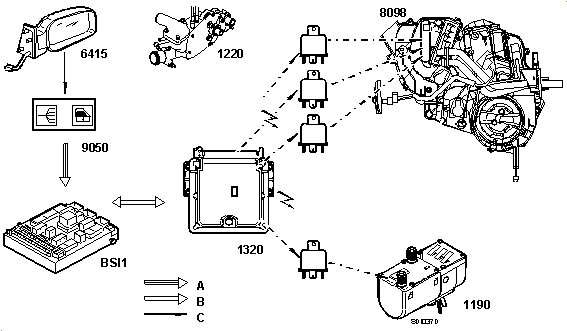
Key:
A - VAN network
B - CAN network
C - Wire connection
(1220) Coolant
temperature sensor.
(1320) Injection ECU.
(6415) Exterior air
temperature sensor.
(8098) Electrical
resistors.
(1190) Additional
heater.
(9050) Front RH door
station.
(BSI1) Built-in
systems interface.
The built-in
systems interface authorises operation of these additional heating systems
depending on the following parameters:
·
coolant
temperature,
·
exterior air
temperature.
B - Presentation of
the additional heating systems
1 - Electrical
resistors
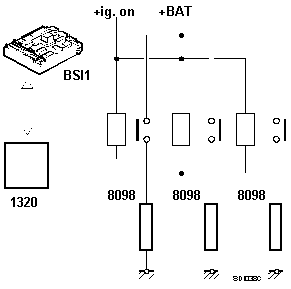
Assembly with 3 relays and 3 resistors
1320 - Injection
ECU
8098 - Electrical
resistors
BSI1 - Built-in
systems interface
The resistors can
each supply a power of 330 watts.
This assembly
allows heating powers of 330, 660 or 990 watts.
2 - Additional
heater
The wiring only allows one heating power to
be obtained.
The additional heater is controlled by an
integrated ECU.
C - control of the
passenger compartment heating systems
The additional heater is switched on in the
following cases:
·
low passenger
compartment temperature (specific curve),
·
when the engine
operating conditions so allow.
D - working out the
additional heating requirements
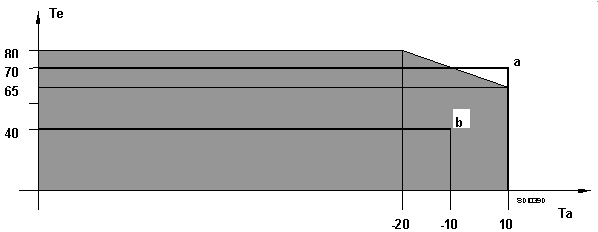
ta - Exterior air
temperature
te - Coolant
temperature
a - Example 1
b - Example 2
(outside shaded
area) heating authorisation zone.
The BSI determines
the passenger compartment heating requirement when the engine is started
depending on the exterior air temperature and the coolant temperature.
Example 1:
·
coolant
temperature = 40°C,
·
exterior
temperature = 10°C,
·
the temperature
conditions are within the additional heating operating zone.
Example 2:
·
coolant
temperature = 70°C,
·
exterior
temperature= 10°C.
·
the temperature
conditions are outside the additional heating operating zone.
E - operation
The BSI determines the passenger compartment
heating requirement when the engine is started depending on the exterior air
temperature and the coolant temperature.
The built-in systems interface operates the
additional heater in the following conditions:
·
engine operating
for more than 60 seconds,
·
engine speed
above 700 rpm,
·
battery voltage
greater than 12 volts (positive electrical balance),
·
coolant
temperature above 40°C.
The built-in systems interface controls the
heater stages progressively:
·
first stage,
·
second stage,
·
second stage and
first stage.
The additional heating is switched off when
the temperature conditions so allow (curve).
The injection ECU is
connected to the following components:
·
a pressurestat
located on the air conditioning circuit,
·
the coolant
temperature sensor.
The ECU can cut off
the supply to the electromagnetic clutch of the air conditioning compressor in
the following cases:
·
engine speed less
than 700 rpm,
·
coolant
temperature greater than 115°C,
·
pressure in the
air conditioning circuit less than 2.5 bars (re-authorisation at 3 bars),
·
pressure in the
air conditioning circuit greater than 30 bars (re-authorisation at 28 bars).
The injection ECU
prevents the engine from being started by prohibiting injection.
Device operating
principle: refer to the corresponding documentation.
Unlocking the system
When the ignition is
switched on, the authenticity of the keys is checked by the BSI.
Locking, ignition off
The injection ECU is
automatically locked 20 seconds maximum after the ignition is switched off.
Parts replacement procedure
Refer to the repair
section.
A - displaying
faults
The appearance of certain faults in the
injection system leads to the illumination of the engine diagnostic LED.
The engine diagnostic LED illuminates if a
fault occurs on the following components or information:
·
capacitor N°1 voltage,
·
capacitor N°2 voltage,
·
high pressure
fuel sensor,
·
high pressure
fuel monitoring,
·
fuel pressure
regulator/sensor coherence,
·
accelerator pedal
sensor N°1,
·
accelerator pedal
sensor N°2,
·
inlet manifold
pressure sensor,
·
air flowmeter,
·
stability of the
ECU 5 volt supply,
·
exhaust gas
recycling function (regulation),
·
high pressure
fuel regulator,
·
diesel injector
fault (1 - 4),
·
inlet pressure,
·
"Swirl"
control electrovalve,
·
telecoding,
·
turbocharging
function.
B - downgraded
operating modes
The injection system manages the following
downgraded modes:
·
an operating mode
with a reduced fuel flow,
·
the other mode
leads to the engine being stopped immediately.
C - reduced fuel
flow
This downgraded
operating mode limits the fuel flow and the engine speed cannot exceed 2200 rpm
(with the injected fuel flow being less than 30 mm3).
The injection
system switches to "reduced flow" mode when a fault is present on one
of the following components:
·
high pressure
fuel sensor,
·
fuel pressure
regulator/sensor coherence,
·
accelerator pedal
sensor N°1,
·
accelerator pedal
sensor N°2,
·
inlet manifold
pressure sensor,
·
air flowmeter,
·
exhaust gas
recycling function (regulation),
·
high pressure
fuel regulator,
·
stability of the
ECU 5 volt supply,
·
diesel injector
fault (1 - 4),
·
inlet pressure,
·
turbocharging
function.
D - air conditioning compressor cut-off
The injection ECU
cuts off the supply to the air conditioning compressor clutch if a fault is
detected on the fan unit control relay coils.
E - High pressure fuel pump 3rd piston deactivator
When the fuel
temperature is above 106°C, the injection ECU deactivates the 3rd piston of the
high pressure pump (solenoid energised).
F - stopping the engine
The system stops
the engine immediately when a fault is present on one of the following
components:
·
Eprom in the
injection ECU
·
engine speed
sensor
·
capacitor N°1 voltage
·
capacitor N°2 voltage
·
high pressure
fuel monitoring
The coolant
temperature warning LED can be controlled by one of the following components:
·
injection ECU,
·
coolant
temperature sensor (2 channels).
Normal LED
operation:
·
the LED
illuminates if the temperature exceeds 118°C,
·
the LED
extinguishes if the temperature falls below 117°C.
The cruise control
device is used to maintain the vehicle speed at a value programmed by the
driver in the following cases:
·
when the
accelerator pedal is not pressed,
·
regardless of the
road profile,
·
without pressing
the brake pedal.
Possibilities
offered by the cruise control device:
·
the driver can
exceed the programmed speed by pressing the accelerator pedal,
·
the driver can
cancel cruise control by pressing the brake pedal, the cruise control switch or
the on/off button.
Note: The cruise control device can only be used
above 40 km/h.
Operation.
When cruise control
is on, the injection ECU permanently compares the programmed speed with the
vehicle's instantaneous speed.
The speed
information is supplied by the speed sensor.
When the programmed
speed is greater than the vehicle's current speed, the injection ECU increases
the fuel flow: the vehicle accelerates up to the programmed speed.
When the vehicle's
current speed is greater than the programmed speed, the injection ECU reduces
the fuel flow: the vehicle decelerates down to the programmed speed.
Cruise control is
cancelled by pressing:
·
the accelerator
pedal,
·
the clutch pedal,
·
the on/off
button,
·
the brake pedal.
Note: In the above 4 cases, the vehicle
decelerates very quickly (accelerator released without declutching).
When cruise control
is cancelled by pressing the cruise control button, the vehicle decelerates
slowly.
operating phases:
particle filtration
The aim of
filtration is to remove the particles retained on the filter walls.
Regeneration consists of periodically burning off the particles
accumulated in the particle filter.
Regeneration can be
natural if the temperature of the exhaust gases is sufficient.
Regeneration can be
caused by the injection ECU if the temperature of the exhaust gases is
insufficient and if the particle filter is clogged.
The injection ECU
artificially increases the temperature of the exhaust gases using
post-injection: this is the "regeneration assistance" phase.
Note: The driving conditions directly affect the
temperature of the exhaust gases and consequently the temperature inside the
particle filter.
The injection ECU
permanently controls the following components:
·
the status of the
filter using a function which monitors the load level of the particle filter,
·
regeneration
assistance using a regeneration assistance function.

|
REF.
|
DESCRIPTION
|
|
1
|
Built-in systems interface
|
|
2
|
Mileage
|
|
3
|
Central diagnostic socket
|
|
4
|
Diagnostic LED
|
|
5
|
Service LED
|
|
6
|
Heated rear screen
|
|
7
|
Fan unit(s)
|
|
8
|
Pre-post heating unit
|
|
9
|
Diesel injectors
|
|
10
|
High pressure fuel pump
3rd piston deactivator
|
|
11
|
Recycling regulation
electrovalve (EGR)
|
|
12
|
Throttle housing control
electrovalve (EGR)
|
|
13
|
Throttle housing control
electrovalve (inlet air heater)
|
|
14
|
Turbocharging pressure
regulation electrovalve
|
|
15
|
Air flowmeter
|
|
16
|
Differential pressure
sensor
|
|
17
|
Exhaust gas temperature
sensor (upstream of the catalytic converter)
|
|
18
|
Injection ECU
|
|
19
|
Exhaust gas temperature
sensor (downstream of the catalytic converter)
|
|
20
|
Fuel additive ECU
|
A - Role
- To determine the condition of the particle
filter (clogging level)
- To request activation of the regeneration
assistance function, when necessary
- To ensure the effectiveness of the
regeneration assistance function.
Main information used for monitoring the
particle filter:
·
pressure
differential,
·
exhaust gas
temperature (downstream of the catalytic converter),
·
exhaust gas
temperature (upstream of the catalytic converter),
·
number of miles
travelled,
·
inlet air flow.
Note: This information depends on the load
level of the particle filter.
B - working out the
particle filter load level
The amount of particles present in the
filter varies its load loss (inlet / outlet pressure differential).
This permanently measured value represents
the load level of the particle filter.
The cartographic maps of the injection ECU
have 6 operating levels determined by curves, from the volume flow of exhaust
gases.
The volume flow of exhaust gases is
essentially calculated from the following parameters:
·
pressure
differential,
·
inlet air flow,
·
atmospheric
pressure,
·
exhaust gas
temperature (downstream of the catalytic converter).
C - particle filter
load levels

D
- Exhaust gas volume flow (l/h)
E
- Pressure differential (mbar)
a
- Filter punctured
b - Filter
regenerated
c - Intermediate
zone
d - Filter
loaded
e - Filter
overloaded
f - Filter
clogged
Note: These statuses can be read using the
diagnostic tool, in parameter measurements.
Zones "a" - "f"
represent the possible clogging levels of the particle filter. The aim of the
injection ECU is to be permanently in zone "b" or "c"
(regardless of vehicle mileage).
When
leaving zone "c" to go to zone "d"
(at a variable
speed depending on driving conditions), the injection ECU
requests regeneration assistance to return to zone "b" or possibly
"c" (depending on driving conditions).
Note: Zones
"a" and "f" are zones where the pressure differential is
abnormal.
The injection ECU requests activation of the regeneration function
in the following cases:
·
load level of the filter passing from zone "c" - "d",
·
load level of the filter in zone "e"
or "f",
·
load level of the filter in zone "c" and driving
conditions favourable for regeneration (average speed greater than 70 km/h) (**),
(**) under these conditions
regeneration will be quicker (regeneration strategy in economic conditions).
Filter
overloaded - zone "e"
The injection ECU switches to the overloaded filter state when
regeneration has failed under certain driving conditions.
This is a warning state.
Filter
clogged - zone "f"
The pressure differential is permanently greater than 900 mbar
(maximum back pressure allowable by the engine) or greater than a limit
depending on the volume flow rate.
Possible causes of
the fault:
·
regeneration assistance ineffective,
·
filter clogged with cerine,
·
incorrect
information from the differential pressure sensor.
The injection ECU suspends all requests for regeneration
assistance and signals a fault.
IMPORTANT: If the "filter clogged" fault occurs, it is essential to
locate the origin of the clogging or else the filter will be damaged.
Filter
punctured - zone "a"
The pressure differential is less than a limit, depending on the
volume flow rate.
Possible causes of
the fault:
·
incorrect information from the differential pressure sensor
·
sealing fault of the exhaust pipe, upstream/downstream information
pipes
·
filter actually punctured
The injection ECU suspends all requests for regeneration
assistance and signals a fault.
Note: The "filter
punctured" fault may be due to an excess temperature during a regeneration
as the amount of burnt particles may be too great.
D - correction of the load
levels depending on the amount of cerine
The cerine in the
fuel:
·
is not burnt with
the soot,
·
builds up on the
walls of the particle filter.
The injection ECU therefore permanently adapts its cartographic
maps depending on the amount of cerine accumulated in the particle filter.
E - effect of driving conditions on the pressure differential
The change in pressure differential also depends on the following
parameters:
·
fuel consumption
(fuel + additive),
·
vehicle driving
conditions (activation of post-injection),
·
exhaust gas
temperature,
·
exhaust gas speed
in the particle filter.
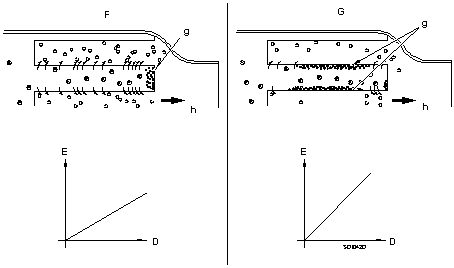
D - Volume flow of
exhaust gases (l/h)
E - Pressure
differential (mbar)
F - Road or motorway
type driving (before regeneration)
G - Urban type
driving (before regeneration)
h -
Filtered exhaust gases
g -
Deposits (cerine, soot, unburned hydrocarbons, oil deposits, etc)
Example F:
·
the deposits
collect at the bottom of the particle filter,
·
the gases pass
easily through the channels and the pressure differential is low.
Example G:
·
the deposits
collect in a stratified layer on the channels,
·
the gases have
problems passing through the channels and the pressure differential is high.
Warning: For the same amount of cerine and for the same
vehicle mileage, the differential pressure may vary.
IV - regeneration assistance management function
A - Role
·
To control
requests from the monitoring function.
·
To activate the
functions required for regeneration, depending on the monitoring states.
·
To determine the
required regeneration assistance level.
·
To control the
effects of post-injection on engine operation.
Regeneration consists of periodically burning
off the particles accumulated on the filter enabling it to remain in zone
"b" or "c".
Filter regeneration depends on the
temperature of the exhaust gases which must be above the soot combustion limit.
There are 2 techniques for achieving this:
·
natural
regeneration,
·
artificial
regeneration (regeneration assistance).
Natural regeneration.
When the exhaust temperature reaches the
regeneration limit itself (high engine load), the particles burn off naturally
in the particle filter. No external actions are required to assist
regeneration.
Artificial regeneration (regeneration
assistance).
Regeneration assistance is a set of
provisions controlled by the injection ECU, the aim of which is to increase the
temperature of the exhaust gases to the regeneration limit.
B - working out the
required regeneration assistance level
There are 2 types of regeneration
assistance, depending on the thermal state of the exhaust pipe:
·
level 1
regeneration assistance (cartographic maps for cold exhaust pipe and catalytic
converter) (catalytic converter pre-heating),
·
level 2
regeneration assistance (cartographic maps for warm exhaust pipe).
C - level 1
Regeneration assistance
When the monitoring function detects a
change in operating zone, it requests activation of level 1 regeneration
assistance (e.g. changing from zone "c" to "d").
Every time
activation is requested, the injection ECU performs the following operations:
·
it prevents
exhaust gas recycling (EGR),
·
it requests
activation of electrical consumers (heated rear screen, fan unit, preheater
plugs) (*),
·
it controls the
opening and closing of the inlet air heater throttle (if necessary),
·
it activates
post-injection (heating of the exhaust gases).
(*) this request is subject to the
electrical load shedding strategy of the BSI (depending on equipment).
D - level 2
Regeneration assistance
The principle is the same as level 1
regeneration assistance but stricter cartographic maps lead to a higher exhaust
gas temperature.
The switch from
level 1 to level 2 regeneration assistance depends on the following conditions:
·
upstream and
downstream exhaust temperature,
·
for as long as
the temperature has not reached a limit.
It is impossible to switch from level 1 to
level 2 regeneration assistance if level 1 has not been active for a given
time.
E - case of
requesting regeneration assistance in economic conditions (by the monitoring
function)
The aim of this request is to activate
regeneration assistance under optimum driving conditions, in order to reduce
fuel consumption.
The principle is
the same as levels 1 and 2 regeneration assistance but with a shorter
post-injection time.
Parameters
required:
·
particle filter
in zone "c", "e" or "f",
·
sufficient
vehicle speed or engine speed/load for a given time
F - conditions for
activating regeneration assistance (by the monitoring function)
Parameters which can activate regeneration
assistance:
·
pressure
differential,
·
distance
travelled between each regeneration.
|
PARAMETERS
|
REGENERATION ASSISTANCE
|
|
Pressure differential
|
Activation
|
Pressure differential
(above a limit "E")
|
|
|
Deactivation
|
Effective post-injection
time (above a limit "K")
|
|
Distance
|
Activation
|
Distance travelled since
last regeneration (above a limit "J")
|
|
|
Deactivation
|
Effective post-injection
time (above a limit "K")
|
G - pressure differential
The pressure differential parameter is used
to activate regeneration assistance independently to the distance information.
When this condition is responsible for
determining activation of regeneration assistance, an effective post-injection
time must have elapsed before regeneration assistance can be stopped (this
allows complete soot combustion, in normal operation).
Monitoring the post-injection time:
·
prevents the
post-injection time being too long (damage to the engine, expansion of the
engine oil),
·
limits fuel
consumption.
H - distance
The distance
parameter:
·
activates
regeneration assistance independently to the pressure differential information,
·
limits the amount
of soot to be burnt off in the filter, should the pressure differential information
fail.
Note: Too
many particles to be burned would lead to excessive temperatures which would
damage the particle filter.
If the average distance of the last 5
regenerations is less than a limit (350 km), the injection ECU switches to the
"distance" strategy.
The distance
travelled since the last regeneration is counted by the main injection ECU
which activates regeneration assistance when this counter reaches a limit
"J".
This limit, or
regeneration frequency, depending on the total distance travelled by the
particle filter.
The regeneration
frequency must be increased to take into account the reduction in capacity of
the particle filter (consumption/quantity of accumulated cerine).
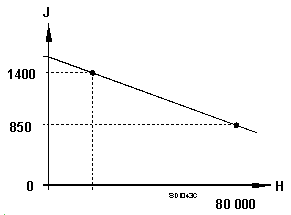
H - Distance
travelled by the particle filter (km)
J - Regeneration
frequency (km)
I - other
conditions
Other conditions
authorising activation of regeneration assistance:
·
coolant
temperature above 60°C,
·
sufficient engine
speed / load.
A - prohibition of
exhaust gas recycling regulation (EGR)
Every time regeneration assistance is
activated, the injection ECU prohibits exhaust gas recycling regulation:
·
exhaust gas
recycling valve closed (prevents any hunting phenomena),
·
throttle housing
open (except if closing is requested to force air to flow into the heater).
B - Activation of
electrical consumers
1 - Role
Reason for activating electrical consumers:
·
to increase the resistant torque of the alternator, thus leading to an
increase in engine load,
·
to facilitate the rise in temperature of the exhaust gases,
·
to quickly place the engine operating point within conditions allowing
effective post-injection.
2 - Operation
The injection ECU asks the BSI to activate
consumers which absorb a high power (alternator saturation request) (*).
(*) depending on vehicle equipment.
Order in which consumers are activated by
the BSI (**):
·
heated rear screen control,
·
request to force the fan unit at low speed,
·
control of the fan unit at mid speed,
·
request to force the pre-post heating plugs.
(**) allowed by the load shedding level of
the vehicle (provided that the battery voltage is above 12.8 volts).
C - Inlet air heater
The inlet air heater is used:
·
to facilitate the rise in temperature of the exhaust gases,
·
to quickly place
the engine operating point within conditions allowing effective post-injection.
Note: The temperature of the air entering the
engine must be between 40°C and 70°C to allow efficient post-combustion.
D - Post-injection
The catalytic converter, located upstream of
the particle filter, is an oxidation catalytic converter.
In the presence of unburned hydrocarbons
(HC), the heat efficiency of the catalytic converter increases.
The temperature of the exhaust gases
increases.
During post-injection:
·
the fuel is
injected after Top Dead Centre (20 - 120° crankshaft),
·
the temperature
of the exhaust pipe increases progressively up to the regeneration limit.
Once the regeneration limit has been
reached, post-injection is maintained until all of the pollutant particles have
been eliminated.
The post-injection flow and time are
determined by cartographic maps, taking into account the engine operating
conditions.
Operating curve:
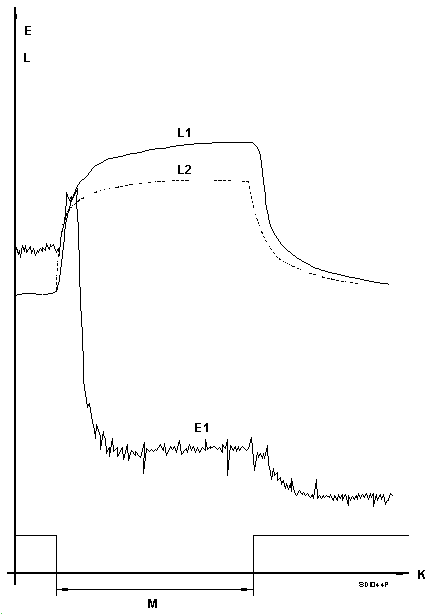
E - Pressure differential (mbar)
E1 - Pressure
differential curve (mbar)
K - Time (s)
L - Temperature (°C)
L1 - Exhaust gas
temperature (downstream of the catalytic converter) (°C)
L2 - Exhaust gas
temperature (upstream of the catalytic converter) (°C)
M - Post-injection control
Operation with
post-injection: the temperature upstream of the catalytic converter is less
than the temperature downstream of the catalytic converter.
Operation without
post-injection: the temperature upstream of the catalytic converter is greater
than the temperature downstream of the catalytic converter (at steady speed).
E - effects on
engine OPERATION
At constant engine load and speed,
post-injection leads to an increase in engine torque.
To maintain the same driving pleasure and
avoid engine hesitation during post-injection, the injection ECU program
incorporates the following strategies:
·
reduction of the
main injection flow,
·
turbocharging
pressure regulation.
1 - Reduction of
the main injection flow
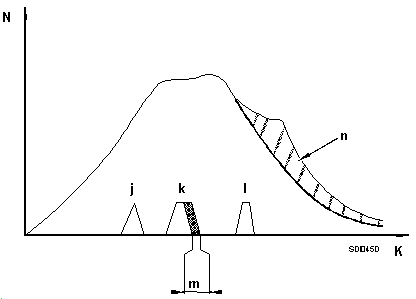
K - Time (s)
N - Cylinder
pressure (bar)
j - Pre-injection
k - Main injection
l - Post-injection
m - Reduction in
main injection time
n - Reduction in cylinder pressure
Reducing the main
injection flow cancels out the increase in torque due to post-injection.
2 - Turbocharging
pressure regulation
To maintain the same engine torque during
regeneration assistance, the turbocharging pressure is regulated.
3 - Operation of
the high pressure fuel pump 3rd piston deactivator
The high pressure fuel pump operates on 3
pistons during regeneration assistance.
Aim of the system: to provide the flow
required by post-injection.
A - operation
To lower the regeneration limit, a cerine
based additive (Eolys) is added to the fuel, which lowers the particle
combustion temperature from 550°C to 450°C.
Cerine is used in an organic solution stored
in an additional tank, located near to the fuel tank.
An additive system has been developed in
order to inject an amount of additive proportional to the amount of fuel
injected.
The system comprises the following
components:
·
a suction device
with a minimum level detector on the additive tank,
·
a system for
injecting the additive into the fuel tank,
·
a specific ECU
for controlling the additive function.
Sender
filtering requires a pumping limit equal to 7 litres of fuel.
Operation:
|
FUEL
ADDITIVE FUNCTION: ENGINE
STATIONARY
|
FUEL
ADDITIVE FUNCTION:
ENGINE RUNNING
|
|
Engine off
|
Non zero vehicle speed
|
|
Memorising of the fuel level "n1"
|
Zero vehicle speed
|
|
Opening of the fuel filler cap
|
Opening of the fuel filler cap
|
|
Memorising of the fuel filler cap open
|
Memorising of the fuel level "n1"
|
|
Closing of the fuel filler cap
|
Closing of the fuel filler cap or non zero vehicle speed
|
|
Starting of the engine
|
Acquisition of the fuel level "n2" - checking of the position
of the fuel filler cap
|
|
Acquisition of the fuel level "n2" - checking of the
position of the fuel filler cap
|
|
|
Case 1: n2 > n1 and fuel filler cap cycle (*) -> fuel additive
function - normal operation
|
|
Case 2: n2 > n1 and fuel filler cap cycle faulty or no cycle ->
fuel additive function - fuel filler cap faulty
|
|
Case 3: n2 = n1 and fuel filler cap cycle -> fuel additive equal
to pumping limit (7 litres)
|
|
Case 4: n2 = n1 and fuel filler cap cycle faulty or no cycle ->
nothing - normal operation
|
(*) fuel filler cap cycle:
·
opening of the
fuel filler cap,
·
closing of the
fuel filler cap.
The
fuel filler cap cycle is effective if the time interval between opening and
closing is greater than 5 seconds.
B - total amount of
additive injected
Every
time additive is added, the additive ECU memorises the amount of additive
injected.
This
value is added to the previously injected values to give a value representing
the total amount of additive injected since the beginning of the particle
filter's life.
This
value is sent to the injection ECU which uses it as the basis for controlling
the clogging level of the particle filter with cerine.
A - displaying
faults
The
appearance of certain faults in the particle filtration system leads to the
illumination of the engine diagnostic LED.
The engine diagnostic LED illuminates when a
fault is present on one of the following components or items of information:
·
differential
pressure sensor,
·
exhaust gas
temperature sensors (upstream and downstream of the catalytic converter),
·
particle filter
clogged,
·
particle filter
punctured.
B - downgraded
operating mode
The injection system controls the following
downgraded mode: an operating mode with reduced fuel flow.
C - reduced fuel
flow
This downgraded operating mode limits the
fuel flow such that the engine speed cannot exceed 2200 rpm under any
circumstances (and the injected fuel flow remains less than 30 mm3).
The injection switches to "reduced
flow" mode when one of the following components is faulty:
·
particle filter
clogged,
·
particle filter
punctured,
·
exhaust gas
temperature sensors (upstream and downstream of the catalytic converter) (*),
·
differential
pressure sensor (*).
(*) 200 km after the fault appears.
D - fuel additive
function - operation in downgraded modes
3 main strategies are used if the additive
system develops a fault.
Fuel filler cap fault:
The additive ECU uses the vehicle speed
information in conjunction with the fuel sender information to inject the
additive.
Fuel sender fault:
The
additive ECU adds an amount of additive equal to that added for a full tank
when the fuel filler cap is opened/closed.
Communications fault on the VAN
multiplexed network:
The
additive ECU adds an amount of additive equal to that added for a full tank
when communications are interrupted for more than 10 seconds.
A - Diagnostic LED (V1300)
Normal LED operation:
·
the LED
illuminates when the ignition is switched on.
·
after the
ignition is switched on, the LED extinguishes after a 4 second timer.
Abnormal LED operation:
·
the LED
illuminates when the ignition is switched on,
·
the LED remains
illuminated.
B - risk of the particle filter clogging
In
the event of prolonged idling, regeneration assistance is ineffective (exhaust gas temperature not sufficient).
The filter clogs up with particles.
The injection ECU informs the BSI.
The BSI requests that a message is displayed
on the multifunction screen (risk of particle filter clogging) in the following
cases: particle filter fault (particle filter overloaded).
The
aim is to encourage the driver to adapt his driving to facilitate particle
filter regeneration.
Within
100 kilometres after the message appears, the customer must drive for at least
3 minutes at a speed greater than 50 km/h which should cause the message to
disappear.
Failure
to comply with this recommendation will lead to the following fault: particle
filter clogged.
The injection ECU informs the BSI which:
·
requests that the
diagnostic LED is illuminated,
·
requests that a
message is displayed on the multifunction screen (antipollution problem).
C - minimum
level of additive reached
The injection ECU informs the BSI which:
·
requests that the
service LED is flashed on the control panel (for 20 seconds after the ignition
is switched on) (*),
·
requests that a
message is displayed on the multifunction screen (low diesel additive level)
(after the ignition is switched on) (*).
(*) depending on vehicle equipment.
MAINTENANCE:
hdi injection system
The injection system requires the use of diesel with a low
sulphur content (less than 350
ppm, EURO3 standard).
Warning: It is forbidden to add products such as fuel
circuit cleaner and regalvanising products.
A - foreword
All operations carried out on the injection
system must be performed in accordance with the following provisions and
regulations:
·
professional
healthcare authorities,
·
prevention of
accidents,
·
protection of the
environment.
Warning: Operations must be performed by specialist
technicians who have been trained in the safety instructions and precautions to
be taken.
B - safety
instructions
1 - High pressure
fuel circuit
IMPORTANT: Given the very high pressures in the high pressure fuel circuit
(1350 bars), comply with the following instructions.
Do not smoke
near to the high pressure circuit during repairs.
Avoid working
near to flames or sparks.
When the engine
is running:
·
do not work on
the high pressure fuel circuit,
·
always remain out
of the range of a possible fuel jet which may cause serious injury,
·
never put your
hand near to a leak on the high pressure fuel circuit.
After switching
off the engine, wait for 30 seconds before starting work.
Note: It is necessary to wait for 30 seconds to
allow the high pressure fuel circuit to return to atmospheric pressure.
All
operations on the fuel circuit are performed in the presence of fuel with
additive. It is recommended that gloves and protective goggles are worn as the
additive is a slight skin irritant.
2 - Fuel additive
circuit
Do not smoke
near to the fuel additive circuit during repairs.
Avoid working near to flames or sparks.
The additive is a slight skin irritant; it
is recommended that gloves and protective goggles are worn.
Protection of the environment: used additive
and items used for cleaning the filter must be recycled.
The additive must be stored under the
following conditions:
·
away from moisture,
·
away from light,
·
away from heat,
·
in its original sealed, opaque packaging, to prevent the solvent from evaporating.
The contents of any opened containers must
not be used and must be recycled.
3 - Operations on
the particle filter
Forced regeneration leads to very high
exhaust gas temperatures (450°C at the exhaust pipe outlet):
·
always keep well away from the exhaust pipe,
·
use suitable exhaust gas extraction equipment,
·
the working area must be clean and tidy,
·
the vehicle chassis must be clean,
·
the fuel tank must contain at least 20 litres of fuel to prevent the fuel
from overheating,
·
the coolant temperature must be above 65°C, before performing a forced regeneration.
It is recommended that a mask and protective
goggles are worn when removing and refitting the particle filter (risk of
inhaling cerine).
4 - Working area
The working area must be clean and tidy.
Parts being repaired must be stored away
from dust.
5 - Preliminary
operations
IMPORTANT: The operator
must wear clean overalls.
Before starting work on the injection
circuit, the connectors of the following sensitive components may have to be
cleaned (see corresponding operations):
·
fuel filter,
·
high pressure fuel pump,
·
high pressure fuel common injection rail,
·
high pressure fuel lines,
·
diesel injector carriers.
IMPORTANT: After removal,
blank the connectors of the sensitive components immediately with plugs, to
prevent the ingress of dirt.
Use the correct tightening torques for the
above components of the high pressure fuel circuit, using a regularly inspected
torque wrench:
·
diesel injectors,
·
high pressure fuel sensor,
·
high pressure fuel lines.
The DW12TED4 engine requires particular care
to be taken when working on the fuel additive circuit.
Cleanliness of the fuel additive circuit:
·
additive tank,
·
additive injector supply and return pipes,
·
additive injector.
III - maintenance
A - injection system
Bleed water from the fuel filter every 20
000 km.
Replace the fuel filter every 60 000 km.
Warning: The fuel filter is designed to be used on a
sophisticated injection system: refer to the procedure given in the mechanical
folder of the vehicle in question. It is recommended that gloves and protective
goggles are worn when handling fuel.
Note: It is recommended that the cleanliness
of the "Swirl" control electrovalve filter is checked periodically.
B - particle
filtration system
Replace or clean the particle filter every
80 000 km.
Top up the additive tank every 80 000 km.
Note: Additive is sold by the Replacement
Parts Department in 1 litre containers (part number PR 9736.65).
IMPORTANT: Use the recommended additive. All other additives (or products) used
will lead to incorrect operation of the particle filtration system.
Dealing with waste:
·
additive and
components used for cleaning the filter must be recycled,
·
the contents of any container which has been opened and not used
immediately must be recycled.
C - diagnostic tools
Diagnostic
tools are used to carry out servicing and diagnostic operations on the particle
filtration system:
·
reading of fault
codes,
·
parameter
measurements,
·
forced
regeneration,
·
reinitialisation
of the total additive quantity.
D - parameter
measurements
Particle filter state
This shows the status of the particle filter (regenerated,
intermediate zone, loaded, overloaded, clogged or punctured).
Particle
filter differential pressure (difference between
inlet/outlet pressure).
This
parameter corresponds to the pressure difference between the inlet and the
outlet of the particle filter.
This
value is similar to the "filter state" parameter.
The
pressure differential varies depending on the vehicle mileage and driving
conditions.
Regeneration assistance state
This
parameter states whether regeneration assistance is in progress (active or not
active).
Total
amount of additive injected
The
total amount of additive injected since the additive tank was last refilled.
Average
distance of last 5 regenerations - distance travelled
since regeneration
Refer to the operating phases - particle
filter section.
E - forced
regeneration
Before
a particle filter is cleaned, forced regeneration allows any remaining soot to
be removed and facilitates cleaning of cerine deposits.
F - Reinitialising
the total additive quantity
After
replacing or cleaning a particle filter, the total amount of additive must be
reset in the additive ECU (calculation of the injection
ECU cartographic maps).
A - Diagnostic before repair
Warning: Before working on
the system, read the memories of all ECUs.
Refer to the fault
finding charts:
·
fault charts
using fault codes,
·
fault charts using
customer complaints (without fault codes).
B - replacing parts
Warning: Before adding or replacing parts, ensure
that the customer has their confidential card.
|
COMPONENTS
REPLACED
|
OPERATIONS
TO BE PERFORMED
|
COMMENTS
/ REQUIRED INFORMATION
|
|
Injection ECU
|
Programming of the injection ECU
|
Access code
|
|
|
Checking of telecoded parameters (if necessary, telecoding of the
injection ECU)
|
Description of the vehicle equipment
|
|
|
Forced regeneration
|
VIN
|
|
Fuel additive ECU
|
Programming of the total additive quantity parameter
|
Total additive quantity parameter from the old additive ECU
|
|
Particle filter
|
Reinitialisation of the total additive quantity (reset)
|
|
|
|
Treatment of the old particle filter
|
|
|
Additive tank
|
Filling of the additive tank
|
|
|
|
Priming of the additive circuit
|
|
|
|
Treatment of the old additive
|
|
|
Additive
|
Filling of the additive tank
|
|
|
|
Priming of the additive circuit
|
|
|
|
Treatment of the old additive
|
|
The following
procedures require the use of the diagnostic tools:
·
programming of
the injection ECU,
·
telecoding of the
injection ECU,
·
programming of
the total additive quantity parameter.
C - programming the
injection ECU
Warning: Swapping an injection ECU between
two vehicles makes it impossible to start the vehicles.
When fitting a new injection ECU, the engine
immobiliser system has to be programmed.
In order to program the engine immobiliser
system, you must:
·
be in possession
of the access code to the built-in systems interface (written on the customer's
confidential card),
·
be in possession
of a new injection ECU,
·
use the
diagnostic tool,
·
carry out an
engine ECU programming procedure: "PROGRAMMING THE ENGINE ECU",
·
download the
injection ECU (if necessary).
D - telecoding the
injection ECU
This procedure is used to reduce diversity.
Parameters which can be telecoded:
·
engine cooling
(fan unit),
·
air conditioning
pressure sensor,
·
gearbox,
·
diesel injection
type,
·
additional
heating,
·
ECUs.
E - replacing the
injectors
Original fit.
Diesel injector carriers marked as a
function of their injection pipe diameter (diesel flow) (class reference 1, 2
or 3).
The cartographic maps of the injection ECU
include the class of injectors fitted on the engine.
Repair.
If an injector is replaced, an injector of
the same class must be fitted.
Warning: Fitting an injector of a different class
leads to incorrect operation of the particle filtration system.
Note: Fitting 4 injectors of a
different class is possible, provided that their new class is telecoded into
the injection ECU.
F - downloading the
injection ECU
The software of the injection ECU is updated
by downloading (ECU with a flash EPROM).
Note: This
operation is performed using the diagnostic tools.
G - programming the
total additive quantity parameter
If the additive ECU is replaced, the total
additive quantity must be programmed into the new additive ECU.
Warning: Swapping an additive ECU between two
vehicles is forbidden.
H - priming the
additive circuit
After opening the additive circuit, it must
be reprimed: switch the ignition on then off again 3 times.
V - warranty return procedure
A - components of
the injection system
Before returning parts to the assessment
centre, the following components must be blanked, placed in a plastic bag and
packaged in their original packaging:
·
diesel injectors,
·
high pressure
fuel pump,
·
high pressure
fuel common injection rail,
·
high pressure
fuel sensor,
·
fuel filter.
B - Injection ECU
The injection ECU will automatically lock if
it is disconnected.
IMPORTANT: When returning parts under warranty, return the injection ECU with
its access code.
wiring diagram

II - parts list
BB00 - Battery
BM34 - Engine relay unit with 34 fuses
BSI1 - Built-in systems interface
C001 - Diagnostic connector
CA00 - Ignition switch
 MC11 -
MC11 -
MC30 -
MC34 - Earths
MC35 -
MM01 -
0004 - Control panel
1115 - Cylinder reference sensor
1150 - Pre-post heating unit
1160 - Preheater plugs
1208 - High pressure pump 3rd piston
deactivator
1211 - Fuel sender pump
1220 - Coolant temperature sensor
1221 - Diesel thermistor
1233 - Turbocharging pressure regulation
electrovalve
1253 - All or nothing EGR electrovalve
1261 - Accelerator pedal position sensor
1263 - EGR + throttle electrovalve
1264 - Swirl electrovalve
1276 - Diesel heater
1285 - Inlet air heater electrovalve
1310 - Air flowmeter
1312 - Inlet air pressure sensor
1313 - Engine speed sensor
1320 - Engine management ECU
1321 - High pressure fuel sensor
1322 - High pressure fuel regulator
1331 - Injector - cylinder n° 1
PARTS LIST (continued)
1332 - Injector - cylinder n° 2
1333 - Injector - cylinder n° 3
1334 - Injector - cylinder n° 4
1341 - Particle filter pressure differential sensor
1344 - Upstream exhaust gas temperature sensor
2100 - Stop switch
2101 - Redundant stop switch
7306 - Cruise control safety switch (clutch switch)
11 -- - Preheater ignition function
15 -- - Engine cooling function
70 -- - ABS function
72 -- - Trip computer, clock function
80 -- - Air conditioning, climate control function
![]()
![]()















































